Datebook: The paintings of Carolyn Castaño, Chicano murals we’ve lost, experimental film and musical tributes
The Pacific Standard Time deluge continues — with cinema, performance, Chicano muralism and music. Plus: a survey of an important Colombian American artist from L.A., an art show inspired by the life and work of activist women, and the immigration experience on canvas. Here are some exhibitions and events to check out in the coming week:
Carolyn Castaño, “A Female Topography,” at Laband Gallery. This is the first career survey of the Los Angeles painter known for brilliant canvases that explore issues of gender identity (particularly in Latin America), the cultural effects of the drug trade, and the social and environmental conditions faced by women in Colombia, the country her family hails from. Her work also riffs on tropical color palettes and pattern. This is one not to miss. Opens Saturday at 6 p.m. and runs through Dec. 10. Loyola Marymount University, 1 LMU Drive, Westchester, Los Angeles, cfa.lmu.edu/labandgallery.
“¡Murales Rebeldes! L.A. Chicana/o Murals Under Siege,” at La Plaza. A historical exhibition looks at a history of Chicano muralism in Southern California through the works that have been censored and destroyed. This includes documentation of important works by iconic SoCal muralists such as Barbara Carrasco, Yreina D. Cervántez, Willie Herrón III (of Asco fame), Roberto Chavez and the collective known as the East Los Streetscapers (David Botello, Wayne Alaniz Healy and George Yepes). As part of the exhibition, Carrasco’s massive portable mural, “L.A. History: A Mexican Perspective” will be placed on view at Union Station starting Sept. 29. Opens Saturday and runs through Feb. 27. 501 N. Main St., downtown Los Angeles, lapca.org.
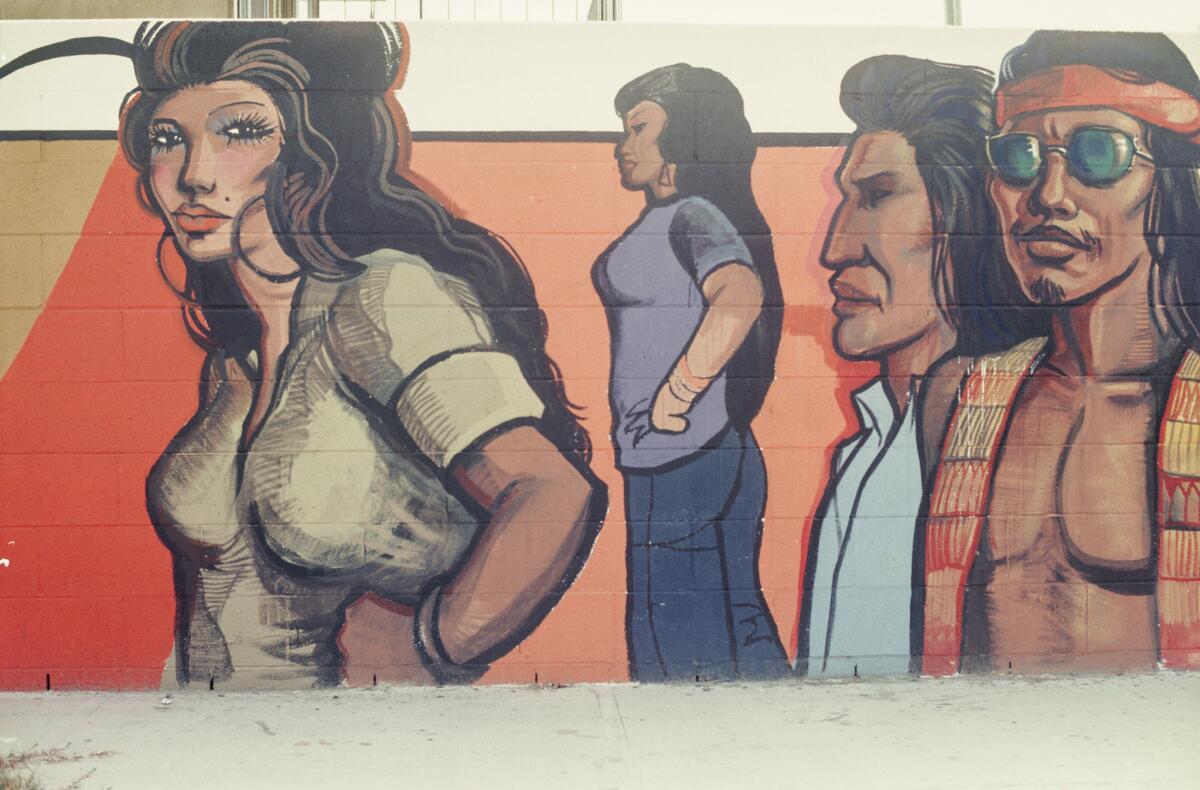
“Ism, Ism, Ism: Experimental Cinema in Latin America,” at REDCAT. This festival brings together key experimental film works made in Latin America or in the U.S. by Latino film directors from the 1930s to today. This includes novelist Gabriel Garcia Marquez’s “The Blue Lobster” and Raúl Ruiz’s surreal “La Maleta.” Also on the lineup are films by women, the Chicano experimentalist Willie Varela and significant (if under-known) works from Brazil and Venezuela. Opens Friday and runs through Sunday. 631 W. 2nd St., downtown Los Angeles, redcat.org.
“The Tide Was Always High: Musical Interventions,” in locations around Los Angeles. Author and curator Josh Kun has just published a new compendium that looks at L.A.’s important place in the history of Latin music. “The Tide Was Always High: The Music of Latin America in Los Angeles” gathers essays that explore the connection of Latin American composers, musicians and performers (including Carmen Miranda, Esquivel and Yma Sumac) to our city. This music series, also organized by Kun, is inspired by that musical history, featuring a tribute to Sumac at the Hammer by figures such as Carmina Escobar, Ceci Bastida and Dorian Wood, a set by Chicano Batman at
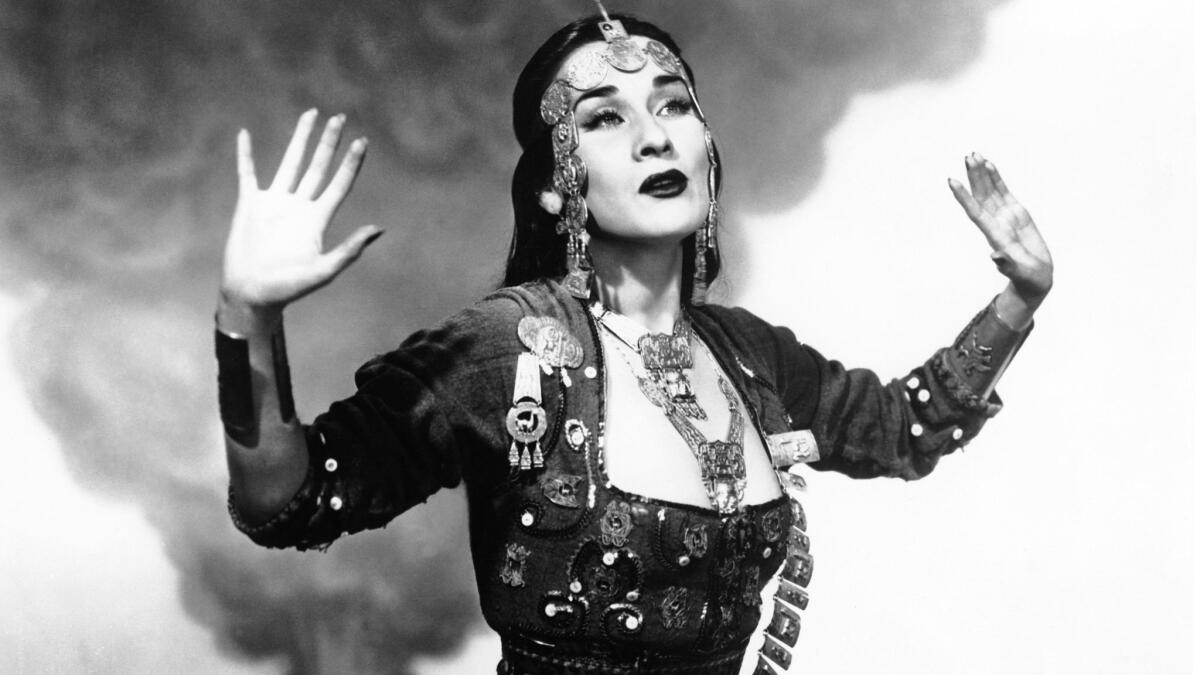
“Latinas Out Loud: ¡Pa’rriba!” at the Hammer Museum. Afro-Colombian pop pioneer Lido Pimienta will be performing a set for the Hammer’s Latin-themed Friday night art party, along with L.A.-based DJ Sister Mantos and the spinners from Chulita Vinyl Club. Friday at 7:30 p.m. 10899 Wilshire Blvd., Westwood, hammer.ucla.edu.
“Memories of Underdevelopment: Art and the Decolonial Turn in Latin America, 1960-85,” at the Museum of Contemporary Art San Diego. A group exhibition organized in collaboration with the Museo Jumex in Mexico City and the Museo de Arte de Lima in Peru focuses on the ways in which Latin American artists have contended with the evaporating promise of Modernism in the 1960s through the 1980s — a period racked by instability and brutal dictatorships. The show includes works by figures such as Hélio Oticica, Lygia Pape, Eugenio Espinoza and others. This is a PST: LA/LA must-see. Through Jan. 21. 1100 Kettner Blvd., San Diego, mcasd.org.
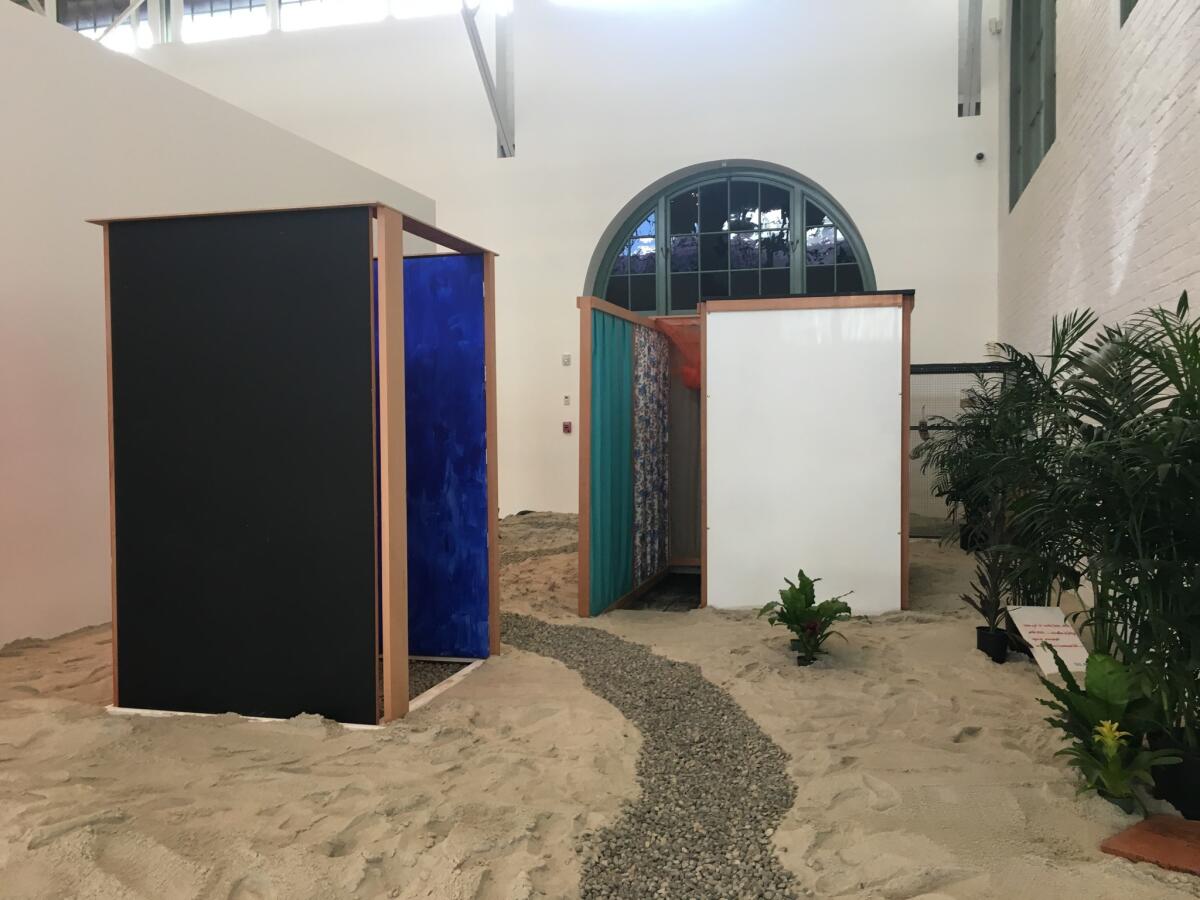
“Coastal/Border,” at the Angels Gate Cultural Center. As part of PST: LA/LA, the San Pedro cultural center has put together an exhibition of performance and installation, organized by Raquel Gutiérrez and Martabel Wasserman, that will have artists engaging with the coast and its various meanings. This includes a choir performance, a ritual happening and a screening of “Greeting Friends” by Paul Pescador, which reconsiders Walt Disney’s famous
Pablo Helguera and Suzanne Lacy, “The Schoolhouse and the Bus,” at the Art, Design & Architecture Museum. This PST: LA/LA show in Santa Barbara pairs work by two artists well known in the field of social practice, both of whom have had mobile projects in the past. Lacy will be showing elements from “Skin of Memory,” a project that gathered personal objects from a Medellín neighborhood that was ground zero in the ‘80s Colombian drug war — and that she showcased in a mobile museum that toured the neighborhood. Helguera, in the meantime, will display elements and documentation from his “School of Panamerican Unrest,” a portable schoolhouse structure that he took all over the Americas and used as a staging ground for discussions about Panamerican ideals and other topics. Opens Wednesday at 5:30 p.m. and runs through Dec. 8.
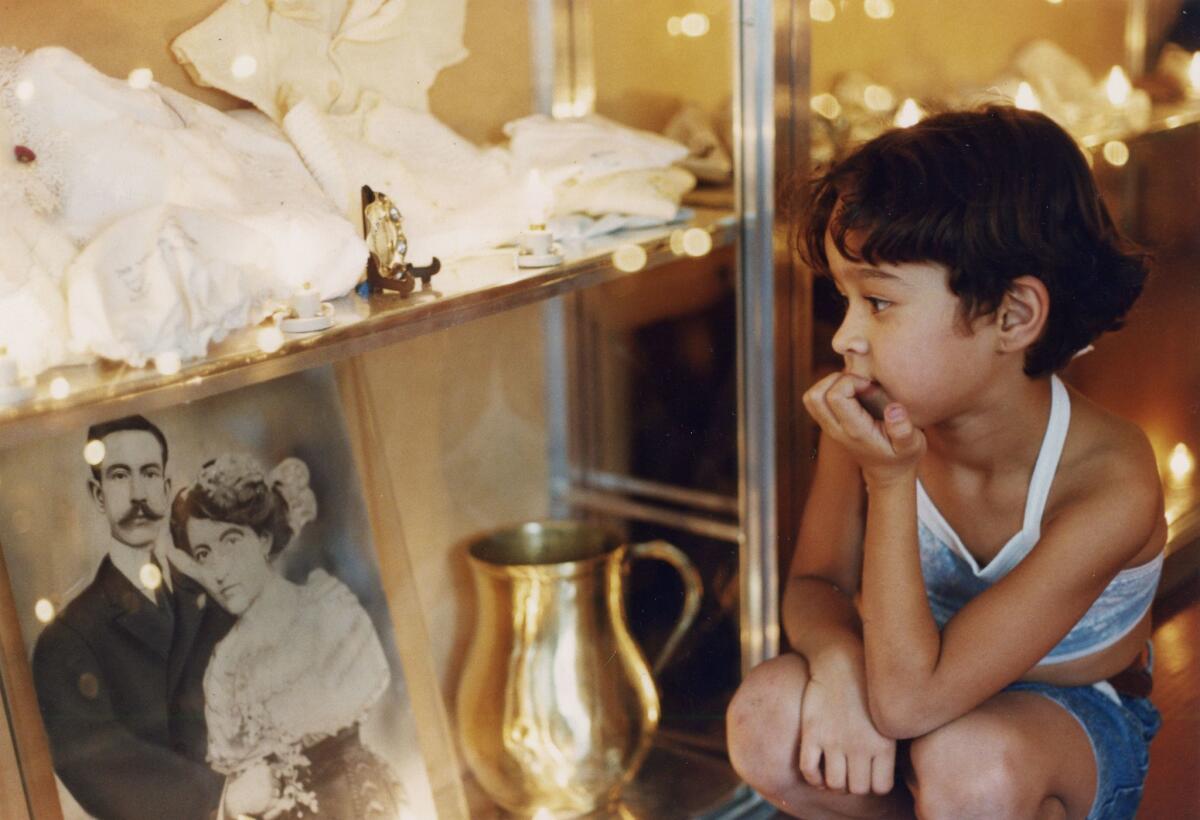
“A Woman’s Place…” at the William Grant Still Arts Center. This exhibition is inspired by the lives and work of five activist women of color: civil rights activists Angela Davis and Ericka Huggins, antiwar activist Yuri Kochiyama, community organizer Elizabeth “Betita” Martinez and health advocate Jewel Thais-Williams (who also happened to be the founder of one of L.A.’s pioneering gay nightclubs). The show will feature ephemera related to these women’s lives — as well as artwork inspired by their journeys. Opens Saturday at 3 p.m. and runs through Nov. 18. 2520 South West View St., West Adams, Los Angeles, wgsac.wordpress.com.
Rafael Cardenas, “From the Holocene,” in Chinatown. An exhibition of all-new work by the Boyle Heights photographer captures the harsh aspects of street and city life in Los Angeles. Opens Saturday at 5 p.m. and runs through Oct. 21. 977 ½ Chung King Rd., Chinatown, Los Angeles, rafa.la.
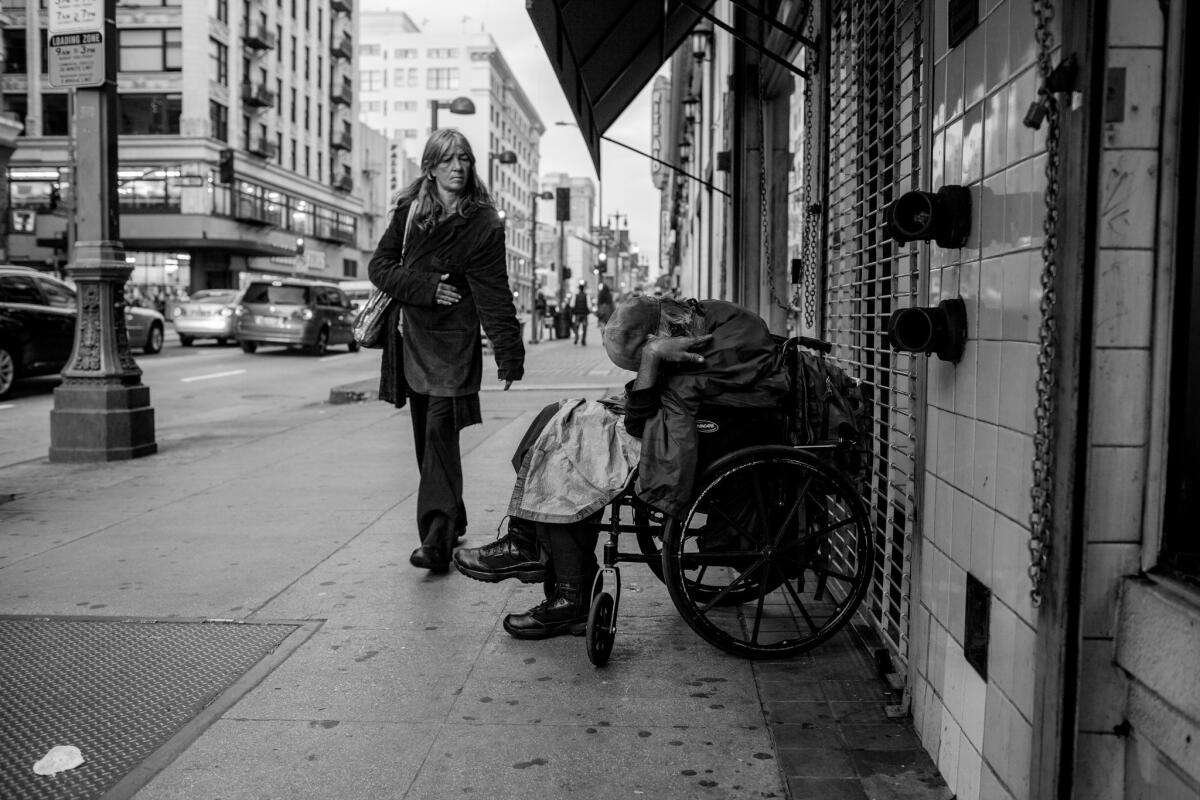
“Barrio Logos: Displacement and Iconography,” at Residency. A group exhibition organized by Oscar Magallanes looks at the most potent symbols of Chicano culture — from murals to fashion to car culture — that have been criminalized even as they have defined the Southern California aesthetic. The show includes work by Mile “El Mac” MacGregor, Patrick Martinez, Pablo Cristi, Vincent Valdez and others. Opens Saturday and runs through Dec. 16. There will be an opening reception and block party on Oct. 7. 310 E. Queen St., Inglewood, residencyart.com.
Amir H. Fallah, “A Stranger in Your Home,” at Shulamit Nazarian. In canvases that capture arrangements of figures, landscapes and objects, the Los Angeles painter channels aspects of the immigrant experience in the United States. Expect lush botanical scenes, layered textiles and figures that often remain an ambiguous part of their setting. Opens Saturday at 6 p.m. and runs through Nov. 4. 616 N. La Brea Ave., Hollywood, shulamitnazarian.com.
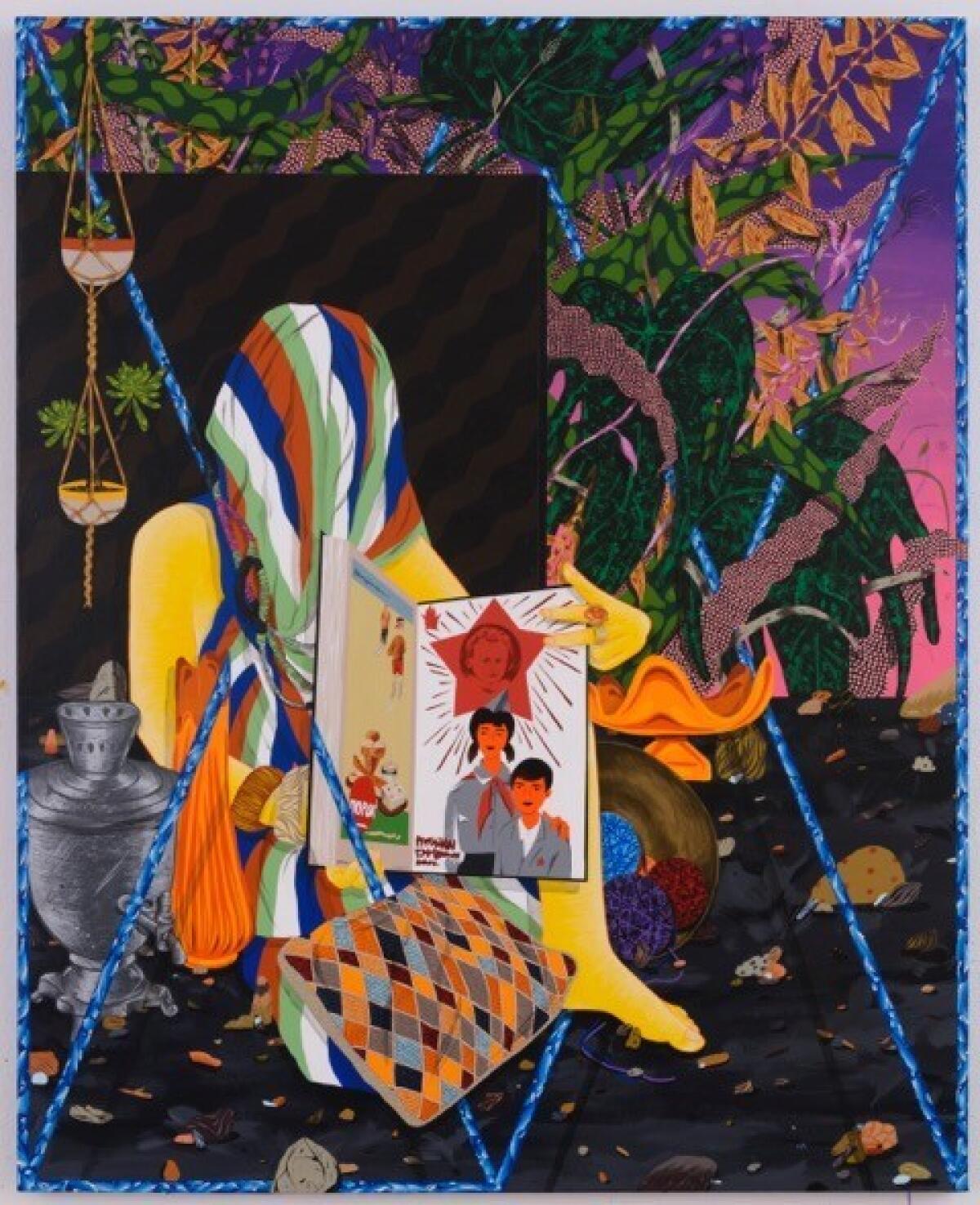
“Vamos a Jugar en las Ruinas: A Survey of Work by Eloy Torrez,” at Plaza de la Raza. The Chicano painter, known for photorealistic canvases that also touch on the surreal, is showcasing three decades worth of work in this broad survey of his painting and drawing. Through Oct. 21. 3540 N. Mission Rd., Lincoln Heights, Los Angeles, plazadelaraza.org.
Retna, “Mano a Mano,” at New Image Art. The Los Angeles graffiti artist, known for his calligraphic murals and canvases, turns to figurative paintings inspired by the Spanish art that arrived in the Americas via colonization. The show is one of the commercial gallery exhibitions associated with Pacific Standard Time. Opens Saturday at 6 p.m. and runs through Oct. 28. 7920 Santa Monica Blvd., West Hollywood, newimageartgallery.com.
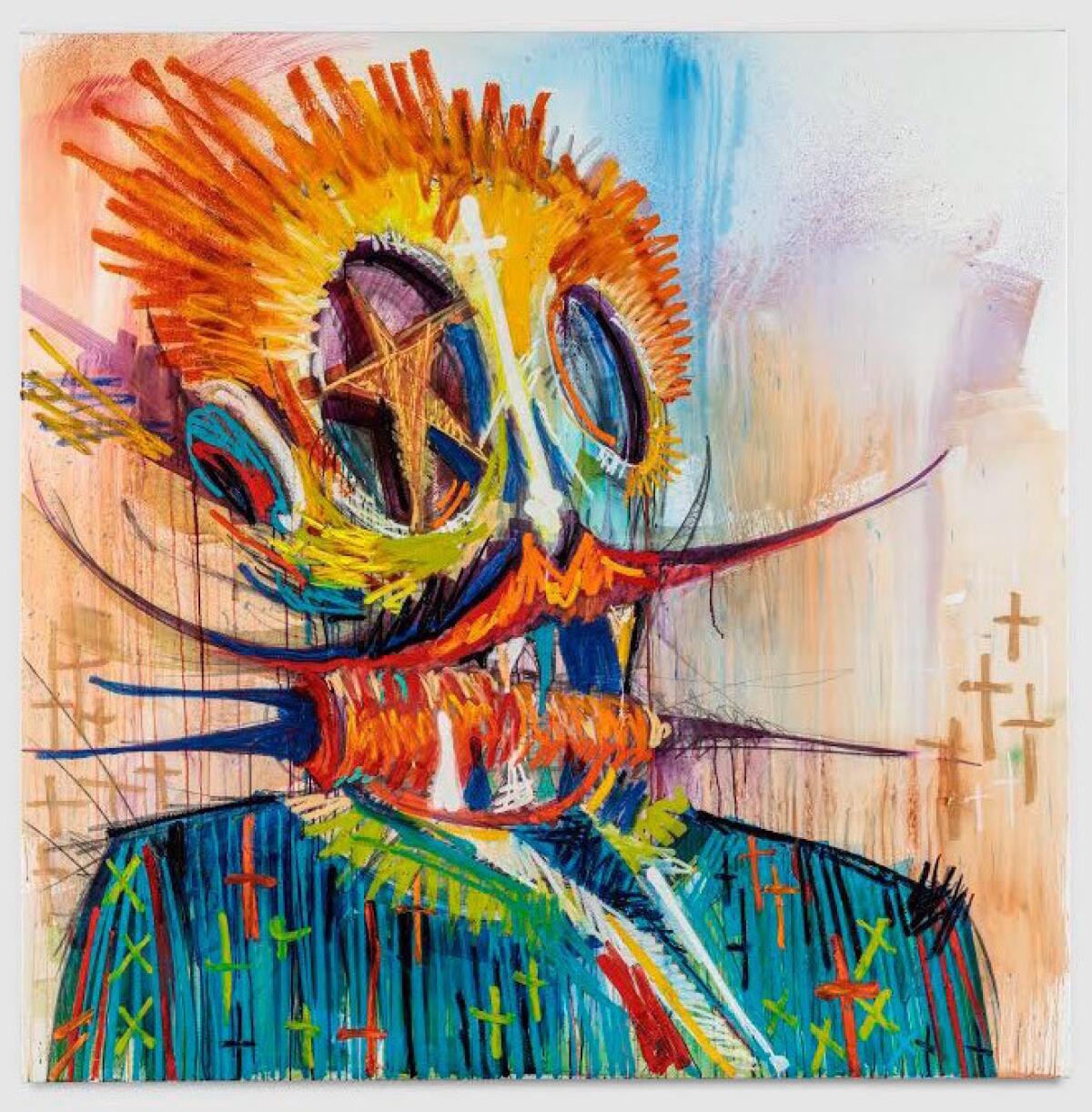
“I Started Something I Couldn’t Finish: The Smiths & Morrissey Collection,” at These Days. This one is for Moz Angeles: The gallery at These Days has pulled together a collection of Smiths and Morrissey posters originally displayed in subway stations and record stores — from the archives of a fan/collector who prefers to remain anonymous. Through Oct. 22. 118 Winston St., 2nd Fl., downtown Los Angeles, thesedaysla.com.
Last chance
Phil Dike, “At the Edge of the Sea,” at the Laguna Art Museum. Raised in Redlands in the early part of the 20th century, Dike was a story designer for Walt Disney (working on animated classics such as “Fantasia”) and also taught at Chouinard (which ultimately became CalArts), and later, Scripps College. But he also painted — watercolor sketches that captured wind, sand and sea. At first, he did this in literal ways. Later in his career, he reached toward the purely abstract. This show gathers 40 years of works from the California regionalist, featuring more than 60 paintings, including many that have never before been seen. Through Sunday. 307 Cliff Dr., Laguna Beach, lagunaartmuseum.org.
Star Montana, “I Dream of Los Angeles,” at the Main Museum. Montana is an artist known for her stark, formally posed photographic portraits — a style she employs on the everyday denizens of Los Angeles, including people she meets on the streets in her native Boyle Heights as well as others that she has met through open calls. The museum also has an exhibition devoted to Alice Könitz’s prototypes for new types of museum seating. Through Sunday. To close out the show, an Aztec dance will be held on Sunday at 2 p.m.114 W. 4th St., downtown Los Angeles, themainmuseum.org.
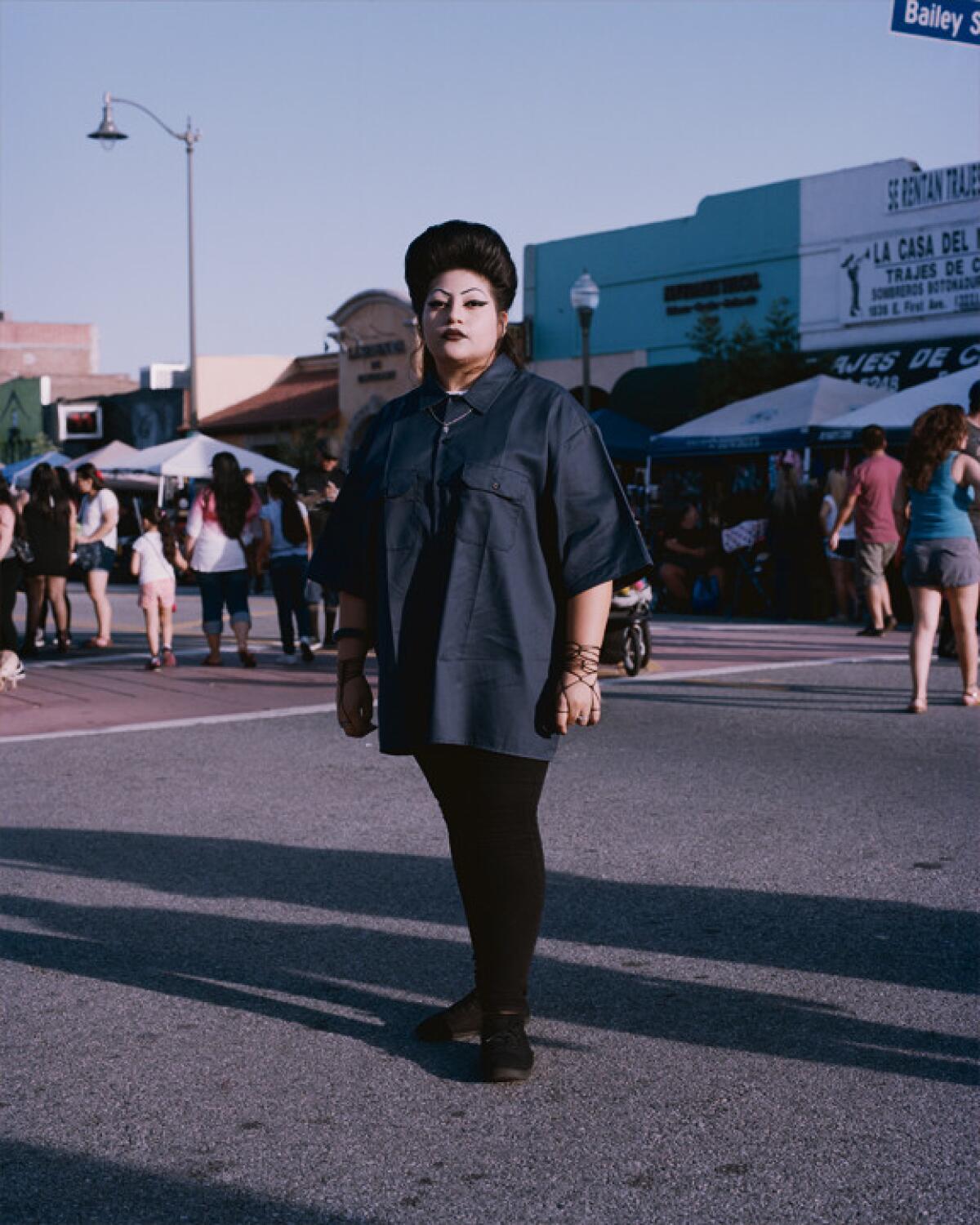
“Maven of Modernism: Galka Scheyer in California,” at the Norton Simon Museum. This exhibition examines the life of a key art dealer: Galka Scheyer, who embraced Modern work early in the 20th century and was partly responsible for bringing the artists known as the “Blue Four” to prominence in the United States. (They were Lyonel Feininger, Alexei Jawlensky, Paul Klee and Vasily Kandinsky.) Born in Germany in the late 19th century, she ultimately settled in California, where she lived in San Francisco and later in Hollywood, where she found an audience that was open to the work and its ideas. The exhibition contains work by the Blue Four, but also objects and other artworks that connect to Scheyer’s personal and professional life. Through Sept. 25. 411 W. Colorado Blvd., Pasadena, nortonsimon.org.
Ongoing exhibitions
Robert Grosvenor, at Maccarone. The gallery is showing three large-scale sculptures by the New York City artist, known for producing works that often seem to defy gravity. (Times art critic Christopher Knight notes the power of the piece he currently has on view at LACMA as part of the group exhibition “Los Angeles to New York: Dwan Gallery, 1959-1971.”) These more recent works see him mixing his signature industrial materials with found and other objects in ways that riff on materials and balance. Through Sept. 30. 300 S. Mission Road, Boyle Heights, maccarone.net.
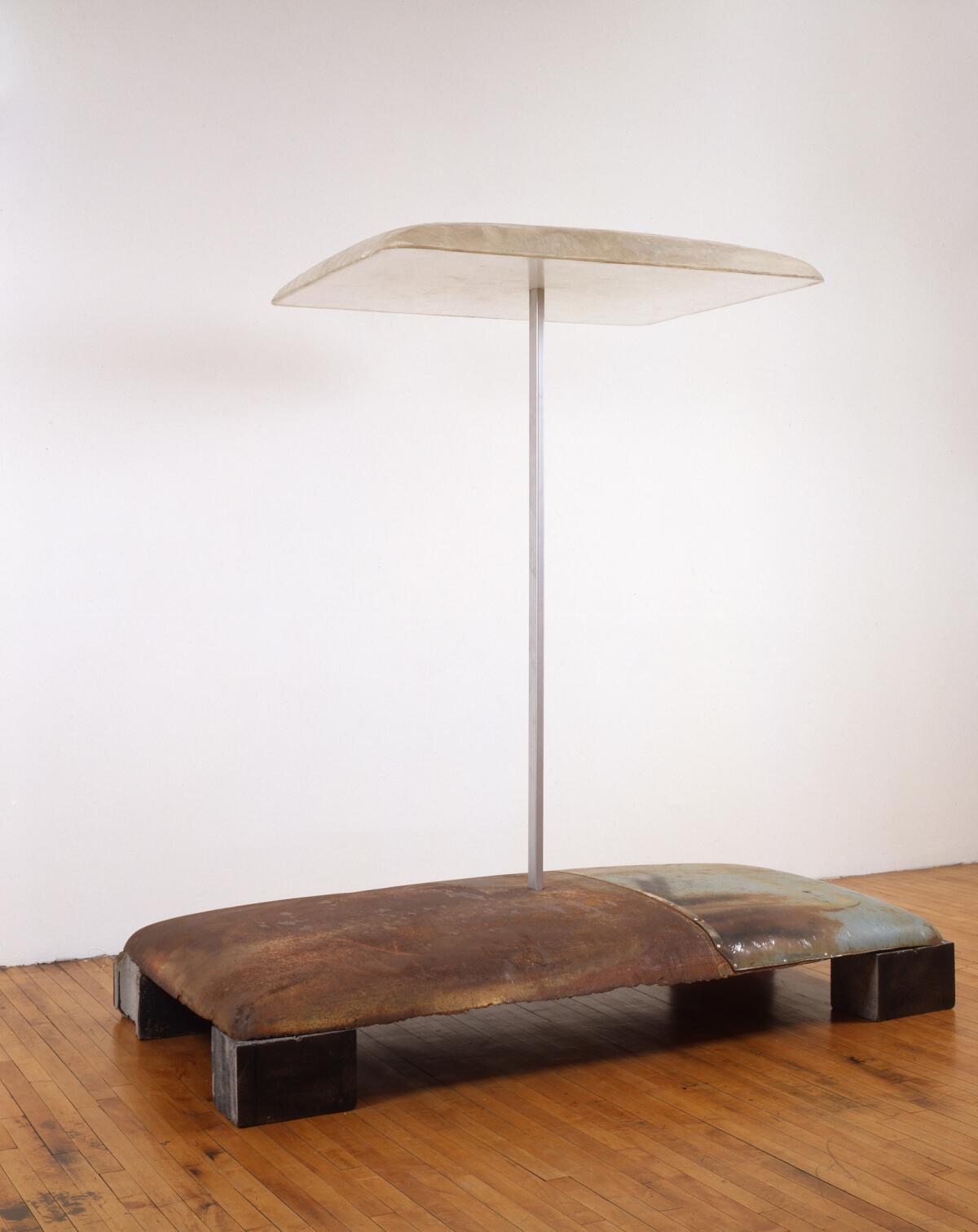
“Sea Sick in Paradise,” at the Depart Foundation Malibu Village. A group show organized by Amy Yao looks at that righteous point where art and surfing intersect — touching on surf culture and history, as well as environmental concerns. This include a mix of pieces by Billy Al Bengston, Jeff Ho, Stanya Kahn, Margaret Kilgallen, Barry McGee, Roe Etheridge and Tin Ojeda — among many others — at a pop-up space in Malibu. Through Sept. 30. 3822 Cross Creek Road, Malibu, departfoundation.com.
“Artists of Mexico: Paintings, Drawings, Prints, Sculpture,” at Jack Rutberg Fine Arts. A group show looks at the Mexican artists who have had an important resonance in Los Angeles, including key Mexican masters such as Rufino Tamayo, David Alfaro Siqueiros and Rufino Tamayo. This includes those who have influenced artists in the area, along with others who have labored in the city — such as Siqueiros, who spent six months living in L.A. in 1932, during which time he painted his famously controversial mural at Olvera Street, “America Tropical.” Through Sept. 30. 357 N. La Brea Ave., Fairfax District, Los Angeles, jackrutbergfinearts.com.
“Gary Simmons: Fade to Black,” at the California African American Museum. In a new lobby installation — one that takes full advantage of the size and scale — Simmons pays tribute to forgotten African American actors and films. On a black background, the L.A. artist features the titles and names of films and individuals important to the early days of Hollywood history, but forgotten over time. The installation offers a good point of connection with the new exhibition “Center Stage: African American Women in Silent Race Films,” which features posters and screenings of pioneering films. Also on view is a pretty terrific exhibition of portraiture called “Face to Face,” featuring standout works by Lynette Yiadom-Boakye, Titus Kaphar and Mequitta Ahuja. The Simmons installation is on view through July 2018; “Face to Face” is up through Oct. 8 and “Center Stage” through Oct. 15. 600 State Drive, Exposition Park, Los Angeles, caamuseum.org.
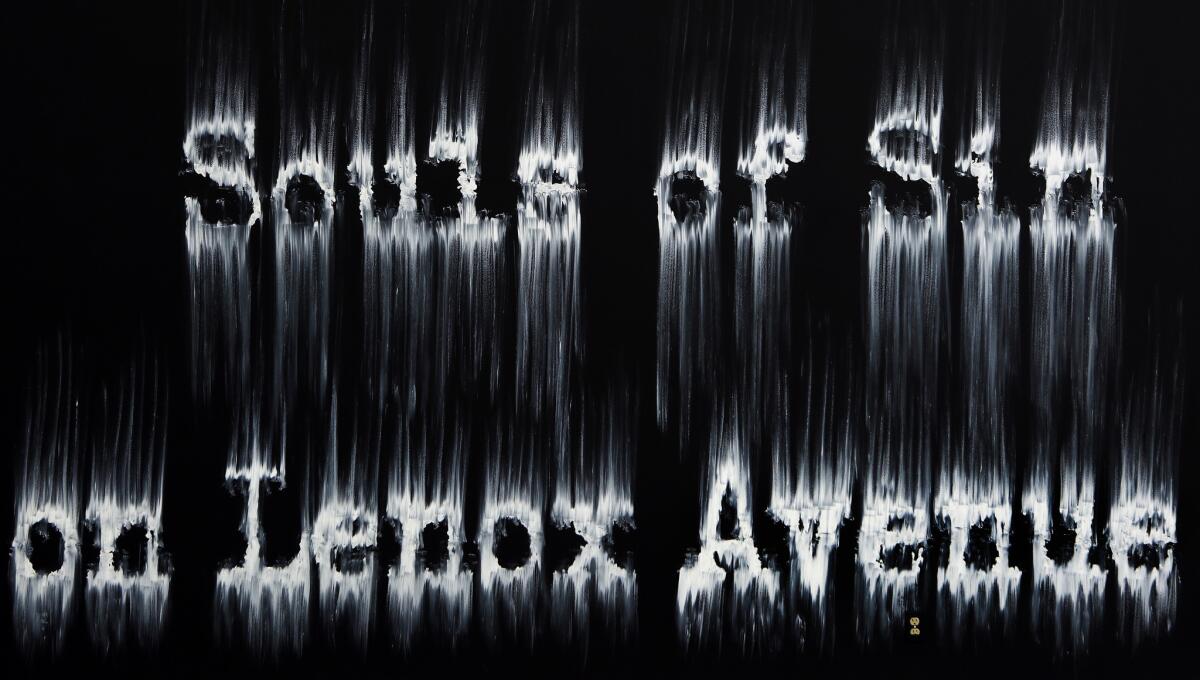
Jeffrey Gibson, “In Such Times,” at Roberts & Tilton. Gibson takes elements from the popular culture — objects, patterns, song lyrics and even bits of detritus — and reconfigures them in wry and dynamic ways. A punching bag, for example, is rendered useless under layers of vivid beads and bells, the phrase “Love is the Drug” written into the patterns. An object of pugilism transformed into a talisman for its exact opposite. Through Oct. 14. 5801 Washington Blvd., Culver City, robertsandtilton.com.
Solange Pessoa, at Blum & Poe. In her first solo exhibition in the United States, the Brazilian artist will be presenting paintings and sculptures that conjure the prehistoric and the organic: ancient tools, early symbols, mollusk fossils and other objects both natural and manmade. Through Oct. 14. 2727 S. La Cienega Blvd., Culver City, blumandpoe.com.
“Conceptual Craft,” at Denk Gallery. A group exhibition featuring the works of Lynn Aldrich, Jeff Colson, Tim Hawkinson and others features work that uses the hand-made to explore conceptual ideas. This includes work that touches on the architectonic, the abstract, the biomorphic and everything in between. Through Oct. 14. 749 E. Temple St., downtown Los Angeles, denkgallery.com.
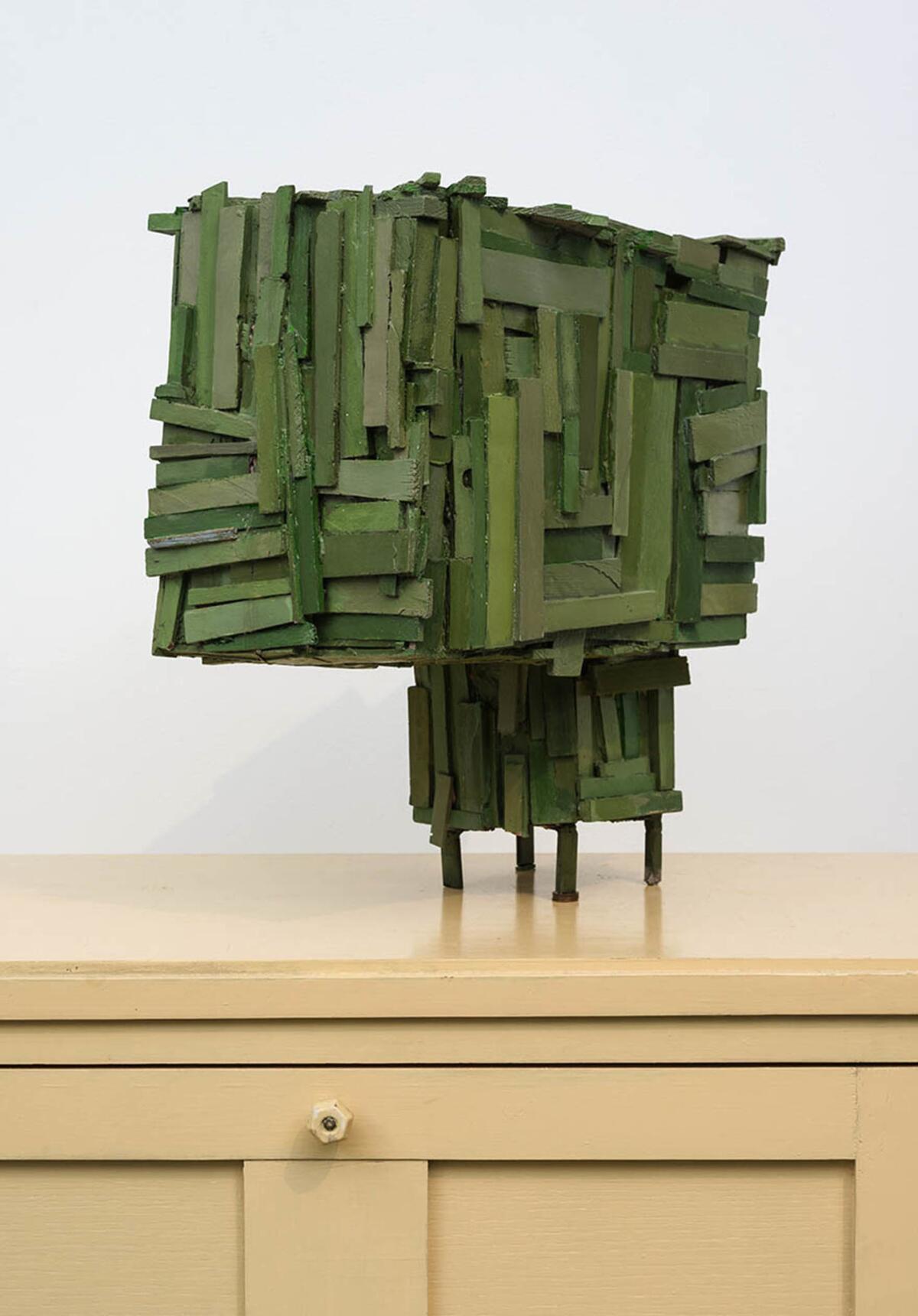
“Home — So Different, So Appealing,” at the Los Angeles County Museum of Art. This is the first of the Getty-funded Pacific Standard Time: Los Angeles / Latin America series — and it couldn’t land at a better social and political moment. The show, a collaborative effort between LACMA, the Museum of Fine Arts Houston and UCLA’s Chicano Studies Research Center, thoughtfully explores the way in which Latino and Latin American artists have used elements of the domestic to comment on issues of the personal and the political in art. The assembled works — by figures such as Felix Gonzalez Torres, Luis Camnitzer and Leyla Cardenas — include installations that ruminate on immigration, urban architecture, control and subtle resistance. The conversation piece? Perhaps Daniel Joseph Martinez’s recreation of a spliced Unabomber cabin painted in Martha Stewart shades. Through Oct. 15. 5905 Wilshire Blvd., Mid-Wilshire, Los Angeles, lacma.org.
“BC to BC: New Ceramic Art from Baja California to British Columbia,” at the San Diego Art Institute. Want to know what’s happening in the world of ceramic art? This broad survey is the show to see, featuring ceramic sculpture drawn from the entire Pacific Coast, from British Columbia in Canada to Baja California in Mexico. This includes work from almost three dozen contemporary artists, including Peter Shire, Allison Schulnik, Juan Villavicencio and Michael Parker. Through Oct. 20. 1439 El Prado, San Diego, sandiego-art.org.
Molly Larkey, a shape made through its unraveling, at Ochi Projects. Larkey takes recognizable structures — letters of the alphabet, cinder blocks, bits of steels — and refashions them into objects that are vastly more open-ended. One work will consist of a series of ceramic pieces that will be dispersed as a series of pendants, given to visitors to wear or to keep — a big work that will exist in many fragments. Through Oct. 21. 3301 W. Washington Blvd., Arlington Heights, Los Angeles, ochiprojects.com.
“Tell Me A Story, Contemporary Mexican Photography,” at Kopeikin Gallery. An exhibition curated by artist Alejandro Cartagena brings together a mix of contemporary photographers working in Mexico — some in ways that toy with the nature of the medium; others that more directly tangle with issues of politics amid the country’s turmoil. Also on view will be a new installation by Cartagena titled “The Collective Memory of the Worst Place to Live in the World Today If You Are Not White,” which examines life in the city of Santa Barbara. Through Oct. 21. 2766 S. La Cienega Blvd., Culver City, kopeikingallery.com.
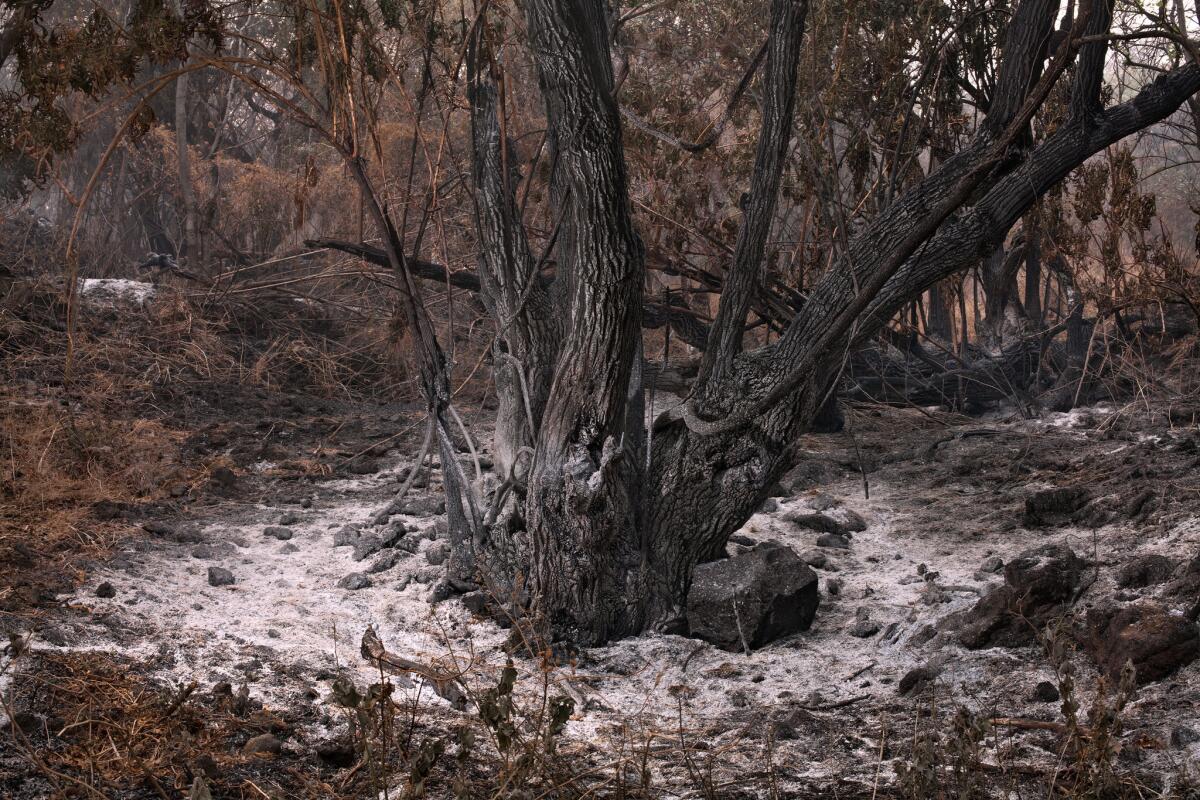
Lorenzo Hurtado Segovia, “Vida, pasión y muerte,” at CB1 Gallery. In his fifth solo show at the gallery, the L.A.-based artist, known for his elaborate works of woven paper (known as papel tejido) is turning his attention to traditional woodworking techniques, explorations of pattern and multimedia pieces that are inspired by aspects of Christian theology. Also on view are a series of beguiling new paintings that employ tar from the La Brea Tar Pits. Through Oct. 21. 1923 S. Santa Fe Ave., downtown Los Angeles, cb1gallery.com.
Carolina Caycedo, Clarissa Tossin and Kim Farkas and LAMOA, at Commonwealth and Council. The gallery is launching a trio of interesting exhibitions this week. The first, titled “Hunger as Teacher,” features work by Colombian artist Carolina Caycedo from her ongoing project “Be Dammed,” which examines the effect of dams on riverside communities as well as larger ecologies. The second, “The Mayan,” showcases art by Clarissa Tossin, an artist preoccupied with architecture, who has created a series of sculptures inspired by the Mayan Revival-style of architecture of the 1920s. And the last, “Le bien comun,” is a collaboration between artist Kim Farkas and the experimental exhibition space, the Los Angeles Museum of Art. Through Oct. 21. 3006 W. 7th St., Suite 220, Koreatown, Los Angeles, commonwealthandcouncil.com.
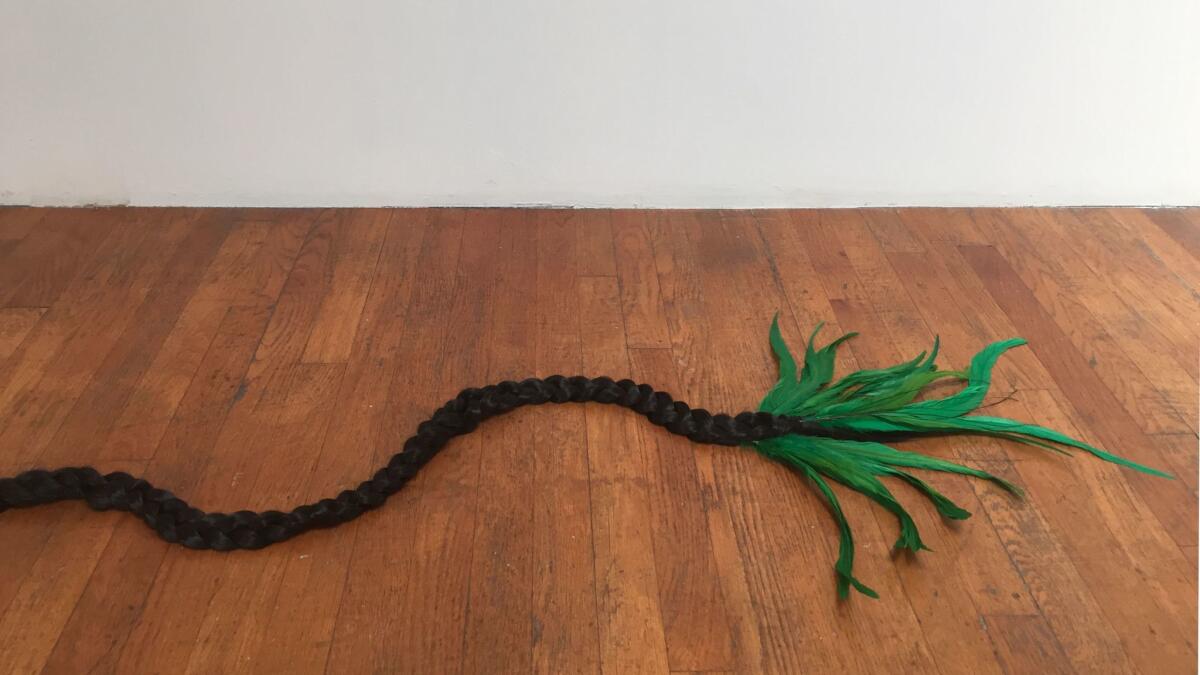
“El eje del mal,” at Ruberta. Five avant-garde Latin American galleries have joined forces to create a rotating exhibition pop-up space that will run for a year. Galería Agustina Ferreyra, Lodos, and BWSMX (all from Mexico City, as well as Proyectos Ultravioleta from Guatemala City and Carne, based in Bogota, each will take turns staging two month exhibitions at a space adjacent to the Pit in Glendale. Through Oct. 22. 918 Ruberta Ave., Unit B, Glendale, ruberta.la.
Adriana Varejao, “Interiors,” at Gagosian Gallery. A broad survey looks at the work of the Brazilian artist, known for paintings and sculpture that riff on the architectonic: This includes renderings of invented saunas (which have a surprising depth) and sculptures that explore the unseemly insides of the systems we build. Through Oct. 25. 456 N. Camden Dr., Beverly Hills, gagosian.com.
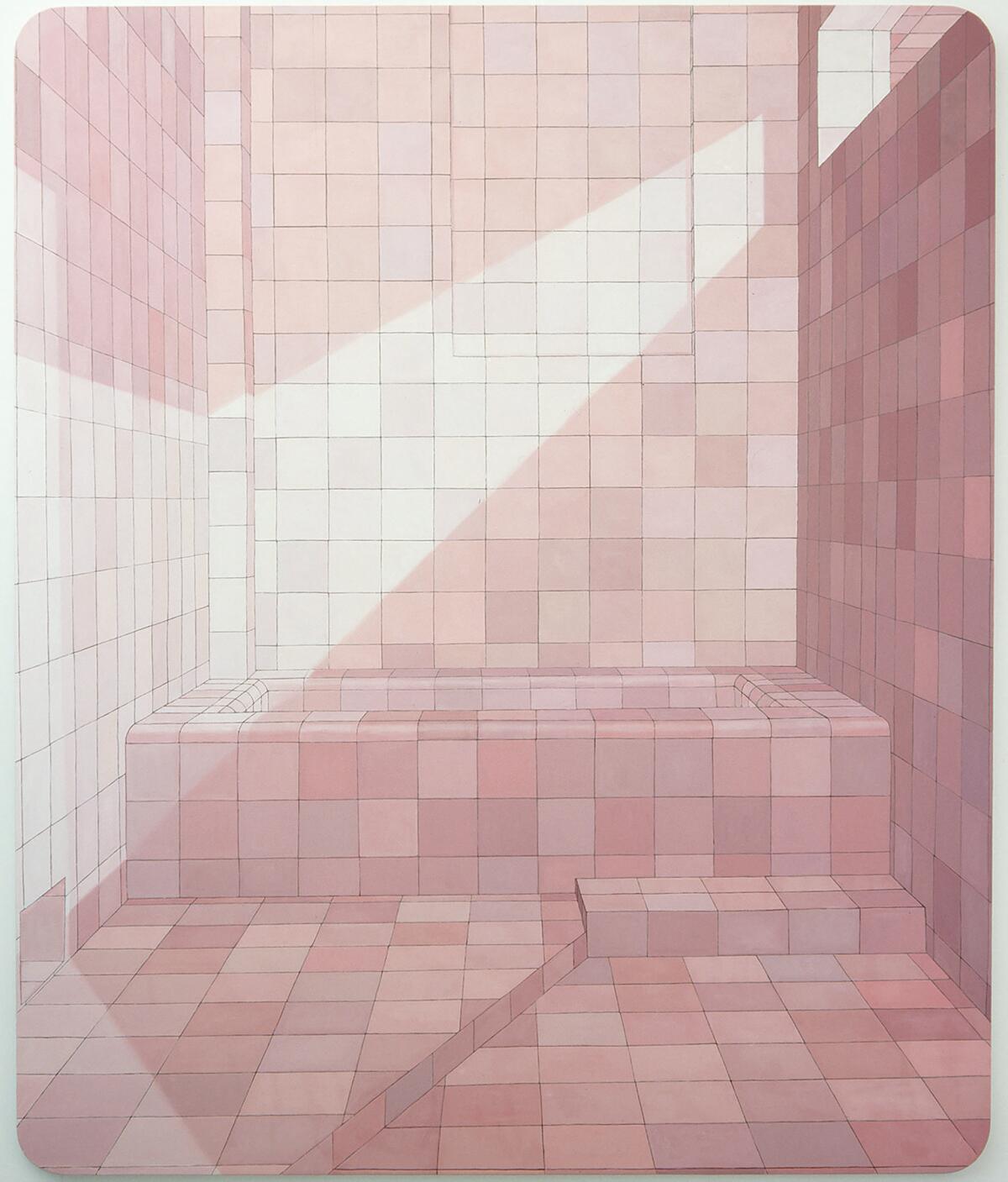
“Becoming America: Highlights From the Jonathan and Karin Fielding Collection,” at the Huntington Library. The Huntington has just redone its American art galleries and now features a new expansion by architects at Frederick Fisher and Partners that adds eight rooms for display. Up first is an exhibition devoted to the Fielding Collection, featuring more than 200 works of 18th and early 19th century American art, including paintings, furnishings and decorative art. Through Oct. 28, 2019. 151 Oxford Road, San Marino, huntington.org.
ProyectosLA, gallery pop-up in Chinatown. Almost two dozen art spaces from around Latin America have gotten together to create a six-week pop-up that will bring together work by artists from spaces such as OMR in Mexico City, Revolver in Peru, Walden from Argentina and Brazil’s Vermehlo. And it’s not a cluttered agglomeration of booths. Instead, a pair of curators — Luiza Teixeira de Freitas and Claudia Segura — have organized a special exhibition that draws from the artists represented by each gallery that features work from the mid 20th century to the present in a stark warehouse setting. This is definitely worth the trip. Opens Sunday at noon and runs through Oct. 28. Werkärtz Studios, 1667 N. Main St, Chinatown, Los Angeles, proyectosla.com.
Regina José Galindo, “Bearing Witness,” at Baik Art. A solo show looks at the work of the Guatemalan performance artist, who is renowned for pushing her body to the limit in performances that touch on the political and social conditions in her native country. Through Oct. 28. On Oct. 27 at 6:30 p.m., the artist will be present for a talk with curator Alma Ruiz. Plus there will be a special closing performance on Oct. 28 at 6 p.m. 2600 S. La Cienega Blvd., Culver City, baikart.com.
Rochele Gomez, “Warm Days, Cool Vons,” at Mandujano Cell. The chain grocery supplies the material for this exhibition, in which the artist uses Vons bags and other materials to create generic representations of beauty. Think: sunsets, blue skies, and puffy white clouds. Through Oct. 28. 171 N. La Brea Ave., #204, Inglewood, mandujano-cell.com.
Lawrence Halprin, “Alternative Scores — Drawing From Life,” at Edward Cella Art & Architecture. This is the first exhibition to bring together the rarely seen drawings of landscape architect Lawrence Halprin, who was known for designing Freeway Park in Seattle and the Sea Ranch community north of San Francisco. The designer used drawing as a way of conceiving projects but also to record the world around him. This includes landscapes, whimsical images of dancers, abstract patterns and random personal objects. Through Oct. 28. 2754 S. La Cienega Blvd., Culver City, edwardcella.com.
“Primordial saber tararear…” at Regen Projects. Curated by gallery artists Abraham Cruzvillegas and Gabriel Kuri, the show takes as a point of inspiration an illustrated cultural map created master Mexican painter and illustrator Miguel Covarrubias. (It serves as a bold wallpaper for the room.) From there, it connects to work by a range of international artists who are in dialogue with Covarrubias’ (and therefor Latin America’s) ideas. This will include pieces by figures such as Germán Venegas, Michael Stevenson and Ariel Schlesinger, among others. It’s full of humor and political bite. A must-see. Through Oct. 28. 6750 Santa Monica Blvd., Hollywood, regenprojects.com.
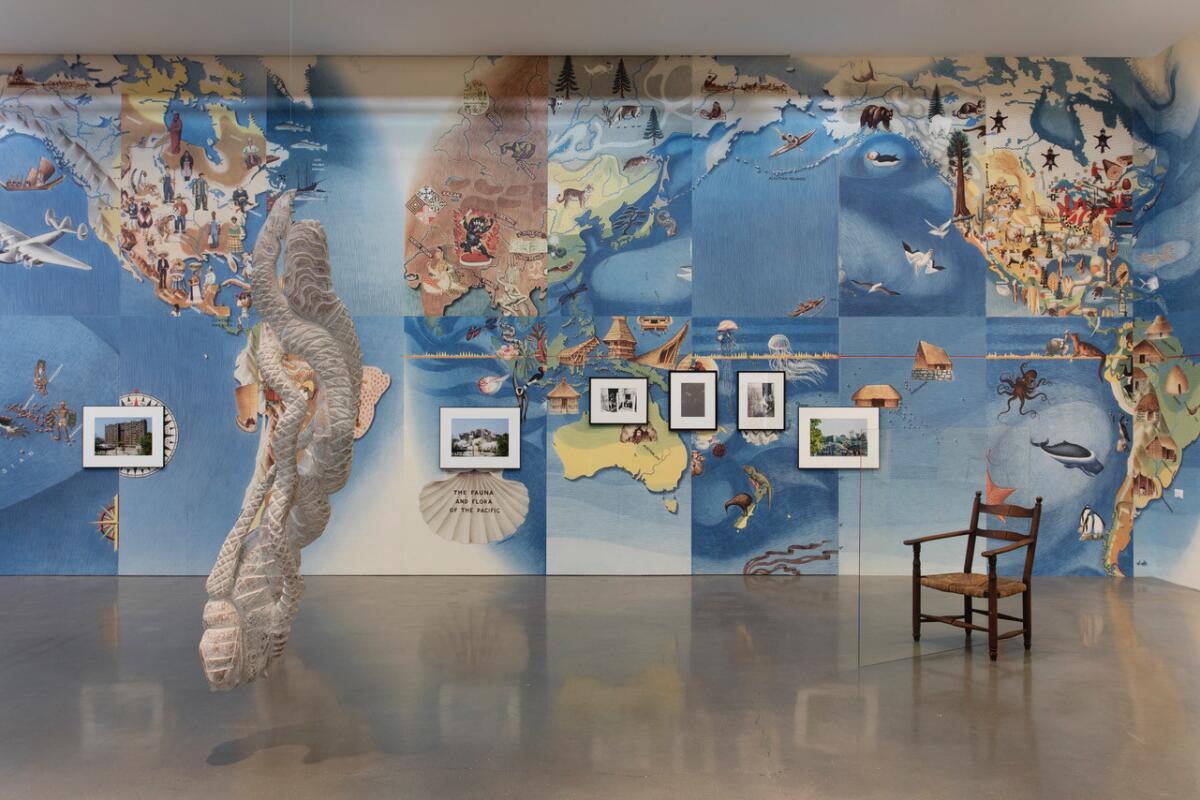
“We Are Here/Estamos Aquí,” at SDSU’s Downtown Gallery. A group exhibition looks at the ways in which artists have tackled the question of the U.S.-Mexico border in photography — be it installation, landscape portraiture or still life. The show includes work from both sides of the border, including pieces by Ingrid Hernandez, Stefan Falke, Tom Kiefer, Pieter Wisse and the group Borderclick. Through Oct. 29. 725 W. Broadway, San Diego, art.sdsu.edu.
“Chingaderas Sofisticadas,” at Kohn Gallery. The gallery has brought together nine artists from Guadalajara, a traditional craft center that is also a burgeoning hotbed of contemporary art. Showcasing works by artists such as Eduardo Sarabia, Cynthia Gutiérrez and Gonzalo Lebrija, among others, the show explores the lively intersection between materials and conceptualism. Through Nov. 4. 1227 N. Highland Ave., Hollywood, kohngallery.com.
Mary Corse, “Then and Now,” at Kayne Griffin Corcoran. One of the masters of the effects of light and space is back with a solo exhibition of new works that riff on the elusive nature of light and reflection, as well as shape and form. Through Nov. 11. 1201 S. La Brea Ave., Mid-Wilshire, kaynegriffincorcoran.com.
“Nemesio Antúnez: Chilean Master,” at Couturier Gallery. When it comes to surrealism in Latin America, it is Chilean painter Roberto Matta who frequently gets all the props. But his countryman Nemesio Antúnez was a key part of the movement. This exhibition brings together 26 paintings and prints from the 1940s to the ’80s, covering the long arc of a productive career. Through Nov. 11. 166 N. La Brea Ave., Hancock Park, Los Angeles, couturiergallery.com.
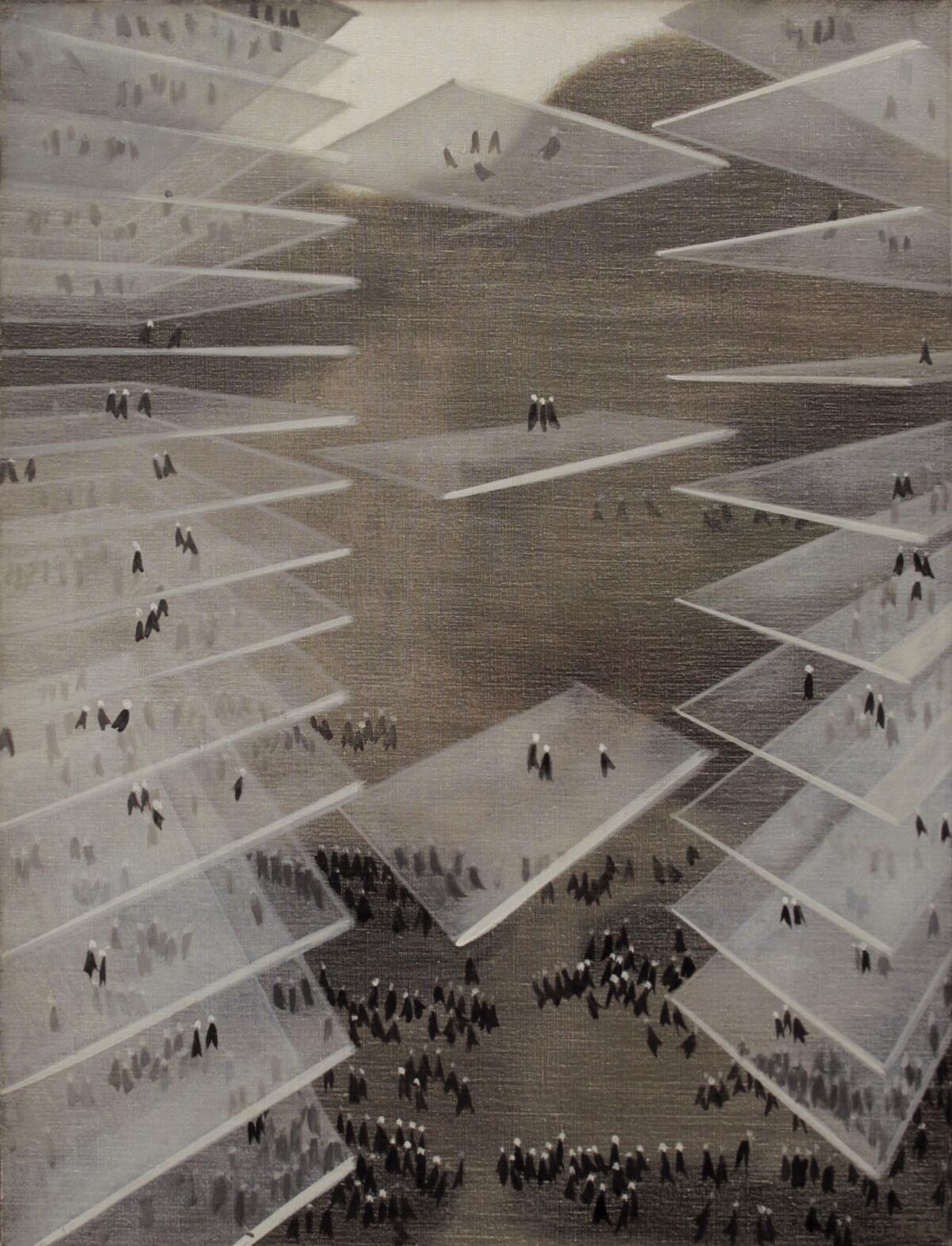
[Eff] the Patriarchy, at Gas. This gallery operates out of a truck that parks around Los Angeles. For this politically minded show (note: it contains salty art language) figures such as Jibz Cameron, Roy Martinez, Ana Roldán, Gallery Y2K and Paul Chan and Badlands Unlimited.take on the topic of refusal. As the press release notes, “especially relevant under
Juan Downey, “Radiant Nature,” at Los Angeles Contemporary Exhibitions and Pitzer College Art Galleries. A two-part exhibition looks at the work of the experimental, Chilean-born artist who was known for his happenings and participatory work, as well as installation pieces that explored the connection between nature and technology. Through Dec. 3 at LACE, 6522 Hollywood Blvd., Hollywood, welcometolace.org. Through Dec. 8 at Pitzer, 1050 N. Mills Ave., Claremont, pitzer.edu/galleries.
“Playing With Fire: Paintings by Carlos Almaraz,” at the Los Angeles County Museum of Art. He was an activist and artist, a founder of the groundbreaking collective Los Four, but also a singular painter whose deeply saturated visions of Southern California — its car crashes and its landscapes — bordered on the hallucinatory. This exhibition represents the first major survey devoted to the Los Angeles artist, who died at the age of 48 from AIDS-related complications. The show features 65 works and will be accompanied by the publication of the first full-length monograph devoted to Almaraz’s life and work. Through Dec. 3. 5905 Wilshire Blvd., Mid-Wilshire, Los Angeles, lacma.org.
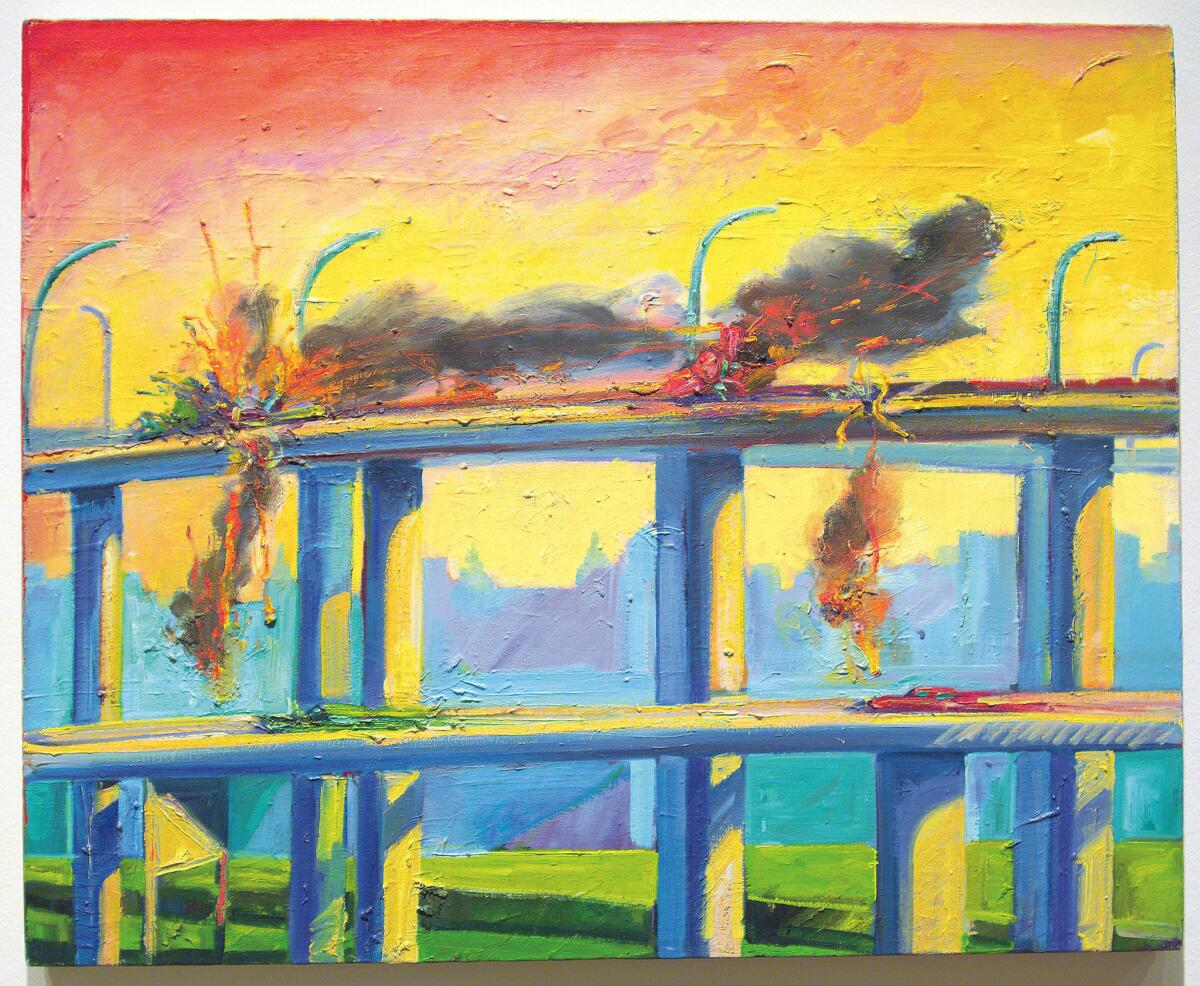
“¡Mírame! Expressions of Queer Latinx Art,” at La Plaza de Cultura y Artes. A group show brings together artists from various Latino backgrounds who explore issues of sexuality and identity in their art, including Xandra Ibarra, Alma Lopez, Julio Salgado and noted photographer Laura Aguilar, known for the striking portraits she creates of herself and others. Through Dec. 9. 501 N. Main St., downtown Los Angeles, lapca.org.
Fran Siegel, “Lineage Through Landscape: Tracing Egun in Brazil,” at the Fowler Museum. A large-scale drawing project by the Long Beach-based artist was inspired by a recent residency in Brazil, where she conducted research in, among other places, the Island of Itaparica, an important center of Afro-Brazilian religious practice. Her 40-foot-long piece consists of a weaving that brings together strips of fabric and drawings of sacred plants on translucent film — a record of the landscapes she inhabited, and the troubled histories some of those represent. Through Dec. 10. UCLA, 308 Charles E. Young Drive North, Westwood, Los Angeles, fowler.ucla.edu.
“David Lamelas: A Life of Their Own,” at the University Art Museum. This is the first monographic exhibition devoted to the pioneering conceptual artist, who first gained international attention in 1968 for his work “Office of Information about the Vietnam War at Three Levels,” staged at the Venice Biennale. The piece consisted of an office-style setting in which an attendant would intermittently deliver headlines about the war in three languages. This exhibition gathers many of Lamelas’ key works — including video installations, performance documentation and his post-minimalist sculptures. Through Dec. 10.
“A Universal History of Infamy: Virtues of Disparity,” at the 18th Street Arts Center. This represents Part 2 of the exhibition of the same name that recently opened at the Los Angeles County Museum of Art. The show includes 16 U.S. Latino and Latin American artists whose work often employs elements of research and anthropology and explores a range of global concerns. This will include small-scale pieces as well as three new projects produced for the site. Through Dec. 15. 1639 18th St., Santa Monica, 18thstreet.org.
Eduardo Sarabia, “Drifting on a Dream,” at The Mistake Room. The L.A.-born, Guadalajara-based artist is known for a wide-ranging practice that includes fabricating tequila and creating traditional-looking ceramics that riff on popular culture, commerce and politics. The show, which functions as an immersive installation, includes a stage that will be employed for a range of events — including as a set for video that Sarabia is in the process of shooting. Through Dec. 16. 1811 20th St., downtown Los Angeles, tmr.la.
“Video Art in Latin America,” at LAXART. A comprehensive look at the history of video art in Latin America, this group exhibition brings together more than 60 works from all over the continent dating back to the 1960s. Organized by theme (instead of region or chronology), the works cover subjects such as political memory, the body and crisis. Through Dec. 16. 7000 Santa Monica Blvd., Hollywood, laxart.org.
“Prometheus 2017: Four Artists from Mexico Revisit Orozco,” at the Pomona College Museum of Art. Pomona College is the site of an important mural by Mexican master José Clemente Orozco. For this PST: LA/LA exhibition, the curators have gathered the work of four female artists working in Mexico — Isa Carrillo, Adela Goldbard, Rita Ponce de León and Naomi Rincón-Gallardo — whose work resonates with Orozco on topics such as history, justice, power and storytelling. At 7 p.m. Nov. 18, Goldbard will perform a fireworks exhibit in conjunction with the show — so mark your calendars. Through Dec. 16. 330 N. College Ave., Claremont, pomona.edu/museum.
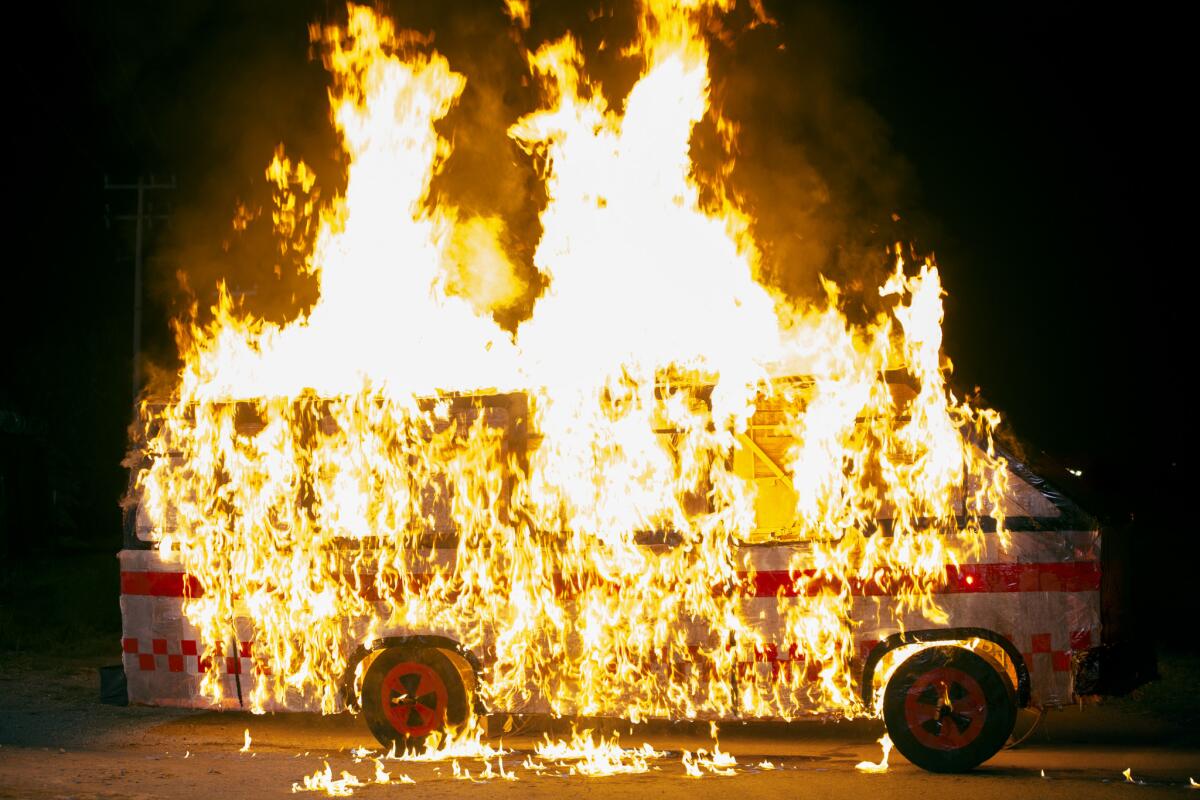
Christina Fernandez, “Prospect,” at Gallery Luisotti. A series of photographs taken through windows capture blurred vistas at historic sites such as the Manzanar internment camp and the Point Fermin Lighthouse in San Pedro. Also included is the series “reflect/project(ion),” collaborative images in which Fernandez projects images onto individuals as she photographs them. Through Nov. 22. An artist’s reception will be held on Sept. 23 at 6 p.m. 2525 Michigan Ave., A2, Santa Monica, galleryluisotti.com.
“Sacred Art in the Age of Contact: Chumash and Latin American Traditions in Santa Barbara,” at the Art, Design & Architecture Museum and the Santa Barbara Historical Museum. This is one of the key PST: LA/LA focusing on historical California — specifically, the early Mission period, when Spanish and indigenous communities first came into contact. The show is focused on religious objects made by individuals of both cultures, including sculpture and painting. At the Santa Barbara Historical Museum through Jan. 14. 136 East de la Guerra, Santa Barbara, sbhistorical.org. At the Art, Design & Architecture Museum and runs through Dec. 8. UC Santa Barbara, 552 University Rd. Santa Barbara, museum.ucsb.edu.
“We the People: Serving Notice,” at the American Museum of Ceramic Art. Directly engaging the complicated politics of our era, the museum has invited a range of ceramics artists to create works that “serve notice” on a range of contemporary issues, including immigration, human rights, freedom of speech and myriad other topics. This includes work by Jessica Putnam-Phillips, Peter Olson, Robert Lugo and many others. Through Dec. 30. 399 N. Garey Ave., Pomona, amoca.org.
“Radical Women: Latin American Art 1960-85,” at the Hammer Museum. Years in the making, this exhibition by independent curators Andrea Giunta and Cecilia Fajardo-Hill, is a survey of art by groundbreaking Latin American and U.S. Latina artists and the ways in which they used the body as canvas and subject. It will bring together artists from all over the continent, some laboring in oppressive social conditions; others, in outright dictatorships — and it will write into the history books work by women that is too often overlooked. Through Dec. 31. 10899 Wilshire Blvd., Westwood, Los Angeles, hammer.ucla.edu.
“Martín Ramírez: His Life in Pictures, Another Interpretation,” at ICA LA. The self-taught artist Martín Ramírez has drawn the attention of museums in the past for the bold, stylized drawings of horses, trains and caballeros he made over decades while institutionalized in a California psychiatric institution during the 20th century. The show represents the debut of the ICA LA in its new downtown space. It was formerly the Santa Monica Museum of Art. Through Dec. 31. 1717 E. 7th St., downtown Los Angeles, theicala.org.
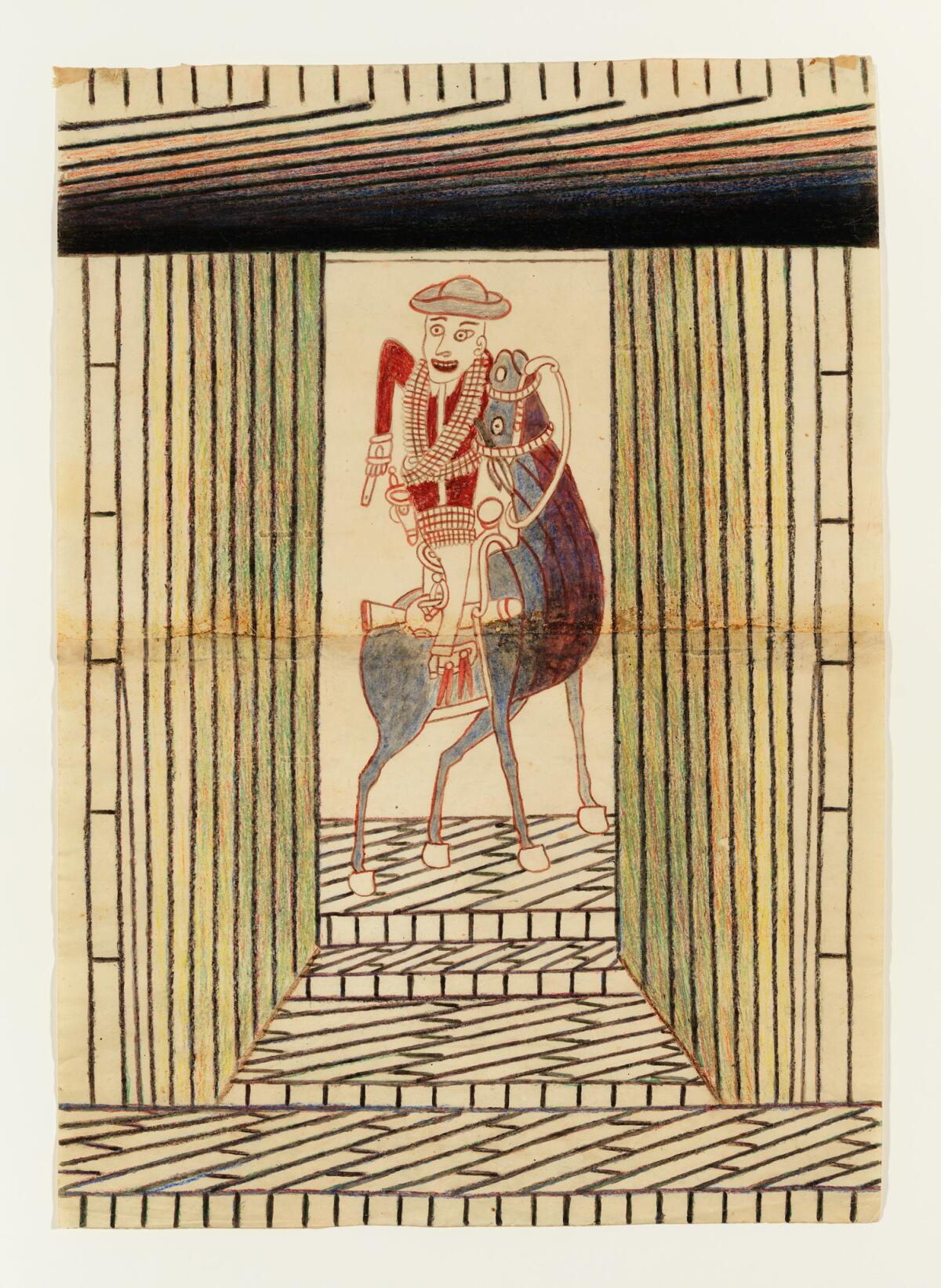
Anna Maria Maiolino, at the Museum of Contemporary Art. This is the first comprehensive U.S. museum survey of the work of the Italian-born Brazilian artist, who over the course of her restless, five-decade career has explored themes of repression, marginalization and womanhood. This includes photography, performance and three-dimensional assemblage. A large room contains one of her vast unfired-clay installations — bursting with small and large forms — a tribute to process and viscera. This too is part of the PST: LA/LA circuit. And it’s one not to miss. Through Dec. 31. 250 S. Grand Ave., downtown Los Angeles, moca.org.
“Nervously Engendered: The Art of Gerardo Velazquez,” at Coagula Curatorial. The pioneering East L.A. musician, founder of the band Nervous Gender, was as much about making experimental music as he was about creating a queer Chicano aesthetic. This show gathers his art work and ephemera from his music career. Through Dec. 31. 974 Chung King Road, Chinatown, Los Angeles, coagulacuratorial.com.
Axis Mundo: Queer Networks in Chicano L.A., at MOCA Pacific Design Center and ONE Gallery. This is another ground-breaking PST: LA/LA exhibition. On view in two locations in West Hollywood, it tracks the art, music and performance work of a network of queer avant-garde artists from Los Angeles contending with issues such as sexuality, feminism, identity, punk music and their racial and ethnic identities. Through Dec. 31. At MOCA PDC, 8687 Melrose Ave., West Hollywood, and ONE Gallery, West Hollywood, 9007 Melrose Ave., West Hollywood, one.usc.edu.
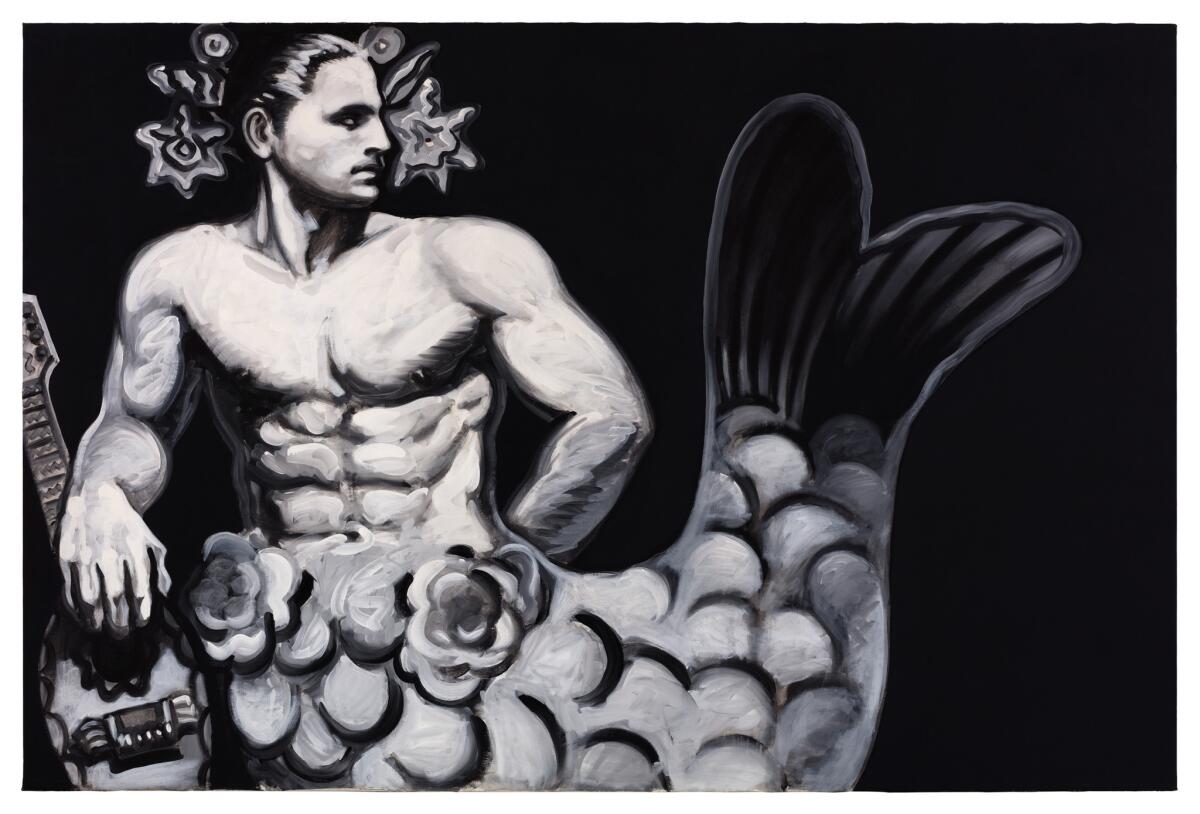
“Neo Native: Toward New Mythologies,” at the Maloof Foundation. This exhibition features more than 40 works by 11 contemporary U.S. artists with Native American roots — including painting, photography, ceramics and more. This includes works by painter Gerald Clarke Jr., ceramicist Diego Romero, conceptual artist Cannupa Hanska Luger and photographer Cara Romero. Opens Sunday and runs through Jan. 7. 5131 Carnelian St., Alta Loma, malooffoundation.org.
“Chagall: Fantasies for the Stage,” at the Los Angeles County Museum of Art. Marc Chagall frequently depicted musicians and dancers in his paintings. He also painted the sets and costumes in which they performed. This exhibition at LACMA, organized by the Montreal Museum of Fine Arts in Canada, gathers Chagall’s costumes, set designs and other ephemera from four productions: the ballet “Aleko,” Stravinsky’s “The Firebird,” Maurice Ravel’s “Daphnis and Chloé” and Mozart’s opera “The Magic Flute.” Expect pure, wondrous theater. Through Jan. 7. 5905 Wilshire Blvd., Mid-Wilshire, Los Angeles, lacma.org.
“The U.S.-Mexico Border: Place, Imagination and Possibility,” at the Craft & Folk Art Museum. Given the political climate, a show about the U.S.-Mexico border could not be more poignant. And this particular exhibition looks at how the world’s most heavily demarcated dividing line has inspired all manner of thinking about art, architecture, design, sculpture, photography and painting. If only our political leaders would go see it. Through Jan. 7. 5814 Wilshire Blvd., Mid-Wilshire, cafam.org.
“Hollywood in Havana: Five Decades of Cuban Posters Promoting U.S. Films,” at the Pasadena Museum of California Art. Part of the Pacific Standard Time: Los Angeles / Latin America series, this exhibition gathers five decades of Cuban posters promoting Hollywood films such as “Moby Dick” and Charlie Chaplin’s “The Kid” (a.k.a. “El Chicuelo”) — a whirlwind graphic tour of film history through a Caribbean lens. The museum also has an exhibition devoted to the work of California painter E. Charlton Fortune, a Californian known for creating impressionist and Modernist landscapes, as well as a range of ecclesiastical work. Through Jan. 7. 490 E. Union St., Pasadena, pmcaonline.org.
“Visual Voyages: Images of Latin American Nature from Columbus to Darwin,” at the Huntington Library. A sumptuous exhibition surveys art, science and environment in Latin America through the publications and drawings of the myriad scientists and explorers who have visited the continent. The show consists of approximately 100 objects drawn from the Huntington’s holdings and dozens of other collections, including illustrated manuscripts, rare books, drawings, and one singularly brilliant feathered cape. Through Jan. 8. 1151 Oxford Rd., San Marino, huntington.org.
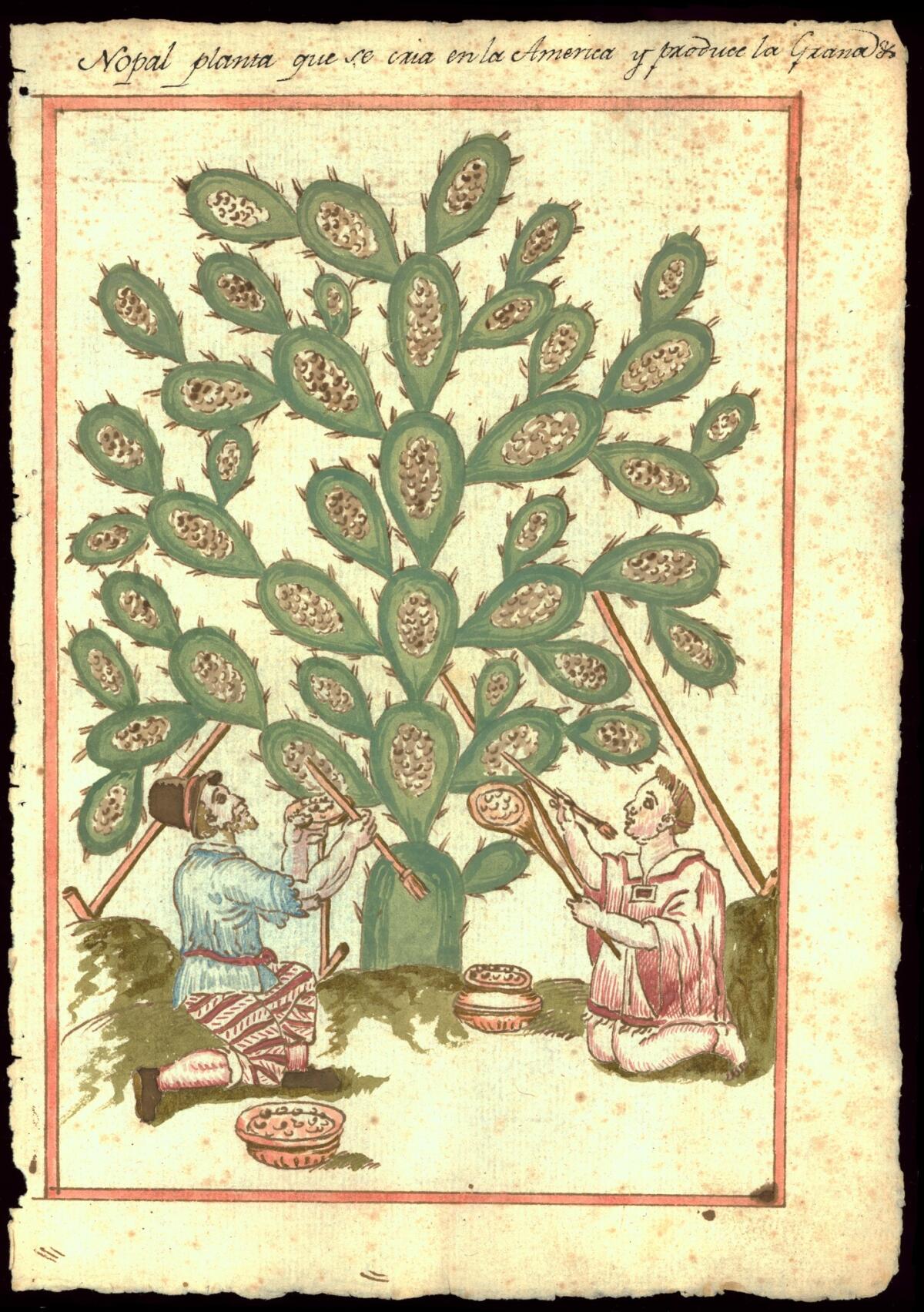
“Kinesthesia: Latin American Kinetic Art, 1954-1969,” by Palm Springs Art Museum. Paris has long been thought of as the heart of the kinetic art movement — art that plays with light, form and shape to create a sensory experience. But this exhibition, organized by guest curator Dan Cameron as part of the Pacific Standard Time: Los Angeles / Latin America series, looks at the contributions to the movement by important South American figures. This includes innovative work by key figures as Carlos Cruz-Diez, Julio Le Parc and Martha Boto. Definitely worth a weekend in the desert. Through Jan. 15. 101 N. Museum Dr., Palm Springs, psmuseum.org.
“How to Read El Pato Pascual: Disney’s Latin America and Latin America’s Disney,” at the MAK Center and the Luckman Fine Arts Center. Organized by curator Jesse Lerner and artist Ruben Ortiz-Torres, this intriguing exhibition looks at the ways in which Disney was influenced by Latin America and how Latin America has taken Disney cartoon characters and co-opted them for its own purposes. It’s a comprehensive look at how culture is reflected back and forth between the U.S. and Latin America — one based on imagery crafted in Disney’s studio right in Los Angeles. For students of history, the related catalog is a must. Through Jan. 14. MAK Center, 835 N. Kings Road, West Hollywood, makcenter.org. Luckman Fine Arts Center, 5151 State University Drive, Los Angeles, luckmanarts.org.
Ruben Ochoa, “Sampled y Surveyed,” at Art + Practice. Over the course of his career, the Oceanside-born artist has long used elements of the urban landscape as his primary material: chain link, concrete, steel and bits of earth. In fact, Ochoa once quite famously jammed a slab of wall and a mound of earth into a room for an installation that looked as if a destabilized portion of freeway had crashed into a white cube. This exhibition at Art + Practice considers Ochoa’s large-scale pieces and the ways in which they employ, manipulate and transform space. Through Jan. 27. 3401 W. 43rd St., Leimert Park, Los Angeles, artandpractice.org.
Judithe Hernández and Patssi Valdez: One Path Two Journeys, at the Millard Sheets Art Center. Two of Los Angeles’ most iconic Chicana artists come together for this two-woman show, which features a broad selection of current works as well as a new collaborative installation. The Millard Sheets Art Center is at the L.A. County Fairgrounds, which means that after you check out the show, you can always pop into the fair for some funnel cake. Through Jan. 28. 1101 W. McKinley Ave., Pomona, pacificstandardtime.org.
“Golden Kingdoms: Luxury and Legacy in the Ancient Americas,” at the Getty Museum. An international exhibition featuring more than 300 masterpieces from throughout Latin America chronicles the most refined examples of craft and artisanry from about 1000 BC to the arrival of the Europeans. This includes sumptuous works of gold, ceramic, painting and textile from the ancient kingdoms of Peru, Mexico, Guatemala and Colombia. Through Jan. 28. 1200 Getty Center Dr., Brentwood, Los Angeles, getty.edu.
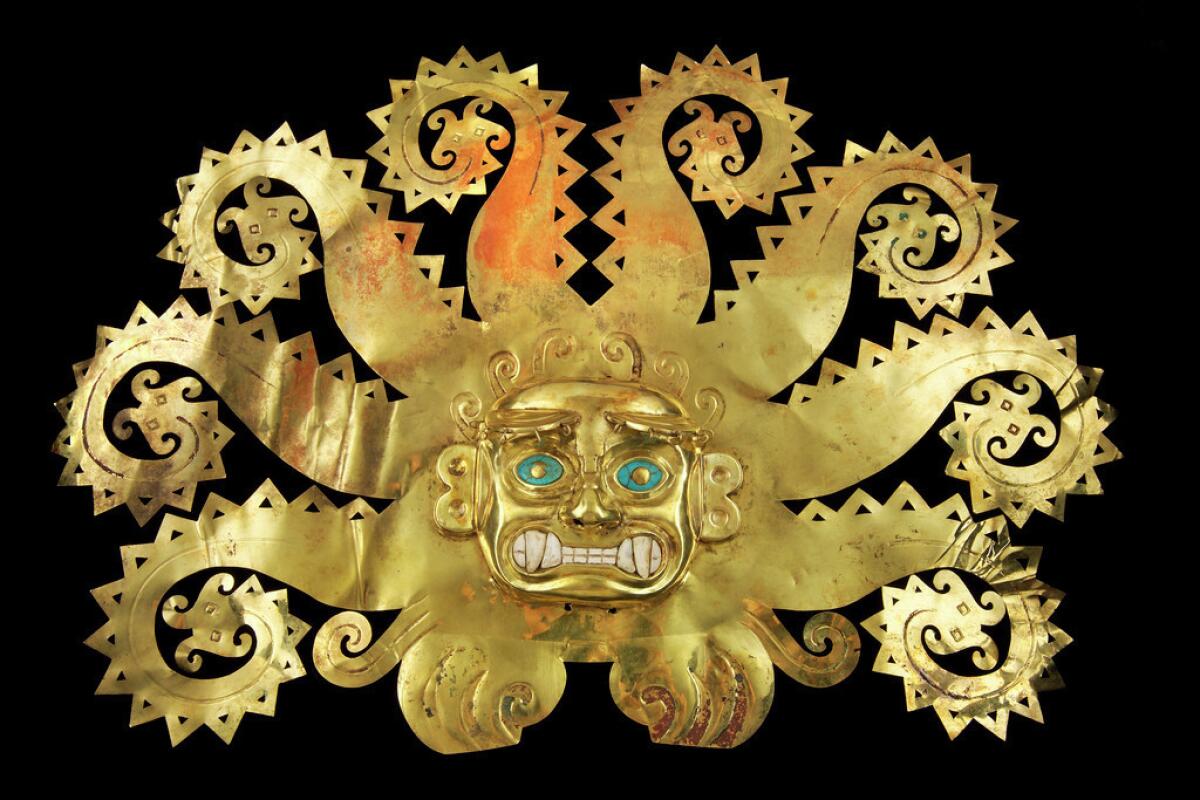
“Condemned to be Modern,” at the Los Angeles Municipal Art Gallery. This exhibition looks at the ways in which Latin American artists have contended with the legacy of Modernist architecture throughout the continent, looking at its innovations, and the ways it has and hasn’t fulfilled its utopic ideals in countries such as Mexico, Cuba and Brazil. Through Jan. 28. 4800 Hollywood Blvd., Hollywood, lamag.org.
Laura Aguilar, “Show and Tell,” at the Vincent Price Art Museum. This is the first comprehensive retrospective devoted to the Southern California photographer, who chronicled queer life in Los Angeles, and also devoted a good portion of her photographic practice to visceral self-portraits she staged in the wilderness. These play with texture, form, body image and what it means to be a woman. It’s a long overdue look at a singular L.A. photographer. Through Feb. 10. 1301 Cesar Chavez Ave., Monterey Park, vincentpriceartmuseum.org.
“Kukuli Velarde: Plunder Me Baby,” at the American Museum of Ceramic Art. The U.S.-based Peruvian artist is known for producing sculpture, inspired by indigenous ceramics, that use ancient symbols to tweak contemporary culture and its prejudices. Through Feb. 11. 399 N. Garey Ave., Pomona, amoca.org.
“La Raza,” at the Autry Museum of the American West. In its day, the civil rights publication “La Raza,” which was based in Lincoln Heights, served as a bible for the Chicano movement, covering protest, policy and everyday life for the Mexican American communities of Los Angeles. Over the years, the paper amassed an archive of 25,000 images, recently digitized by the Chicano Studies Research Center. Many are now on view as part of this PST: LA/LA show at the Autry — and in a time of political strife surrounding the issues of civil rights, this exhibition couldn’t be more timely. Also on view is Harry Gamboa Jr.’s photographic series “Chicano Male Unbonded.” Through Feb 10. 4700 Western Heritage Way, Griffith Park, Los Angeles, theautry.org.
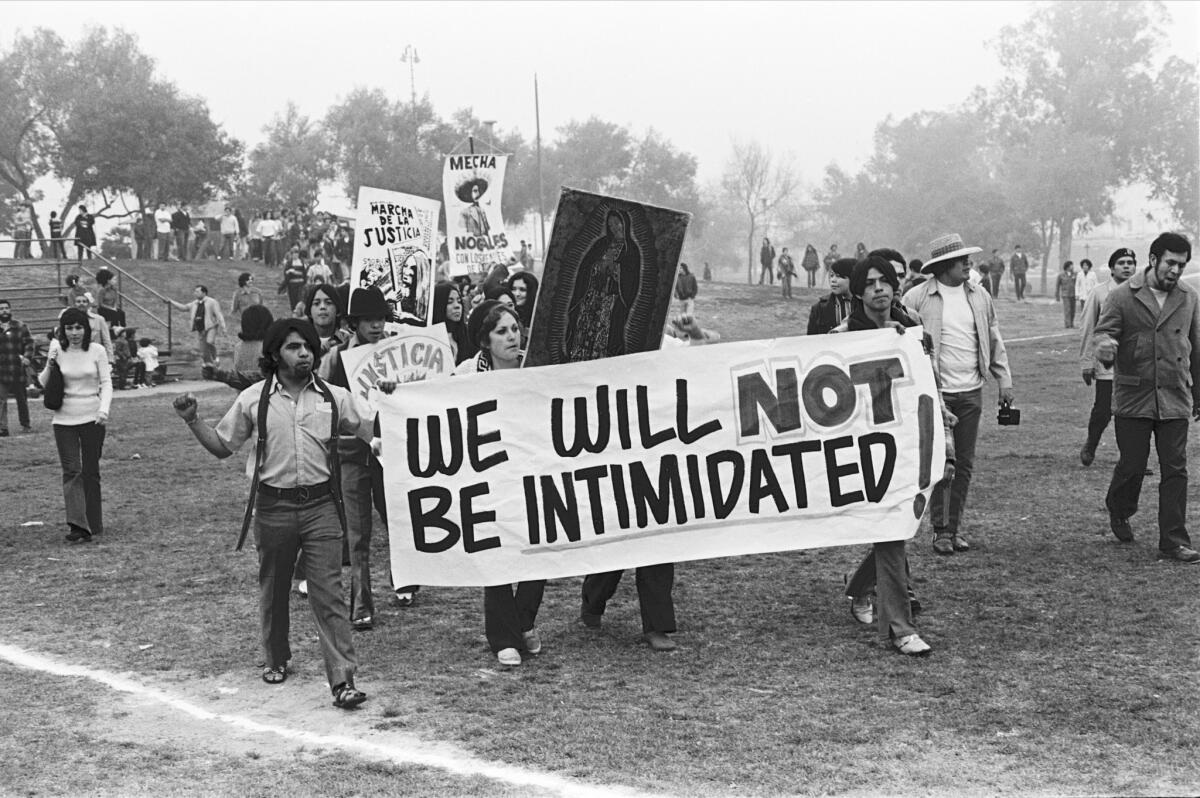
Standing Rock: Art and Solidarity, at the Autry. The Standing Rock protest in North Dakota attracted an unprecedented protest that brought together native and non-native cultures in a unified front against the proposed Dakota Access pipeline. This exhibition gathers ephemera from that action, including poster art, clothing and photographs. Through Feb. 18. 4700 Western Heritage Way, Griffith Park, Los Angeles, theautry.org.
“A Universal History of Infamy,” at the Los Angeles County Museum of Art. The latest in the PST: LA/LA series brings together the work of 16 Latin American and U.S. Latino artists that challenge notions of region. Many of the artists don’t inhabit a single country — often going back and forth between multiple locations, cultures and ideas. The show includes installation and performance by artists such as Brazilian Carla Zaccagnini, who is preoccupied with history; Stefan Benchoam and Jessica Kairé, who manage an egg-shaped mini-museum in Guatemala; and Colombian Angeleno artist Gala Porras-Kim, whose work often explores the ways in which culture is presented and interpreted. The show takes place across three venues, including the BCAM galleries at LACMA, the museum’s exhibition space at Charles White Elementary School near MacArthur Park (opening Dec. 9), and the 18th Street Arts Center in Santa Monica (through Dec. 15), where a number of the show’s artists had residencies. Through Feb. 19. 5905 Wilshire Blvd., Mid-Wilshire, Los Angeles, lacma.org.
“Día de los Muertos: A Cultural Legacy, Past, Present & Future,” at Self Help Graphics & Art. A historic exhibition looks back at the celebrations for Day of the Dead organized by the community arts nonprofit since 1972. This includes photography, historical prints and three specially commissioned altars from Ofelia Esparza, Marcus Kuiland-Nazario and Gerardo Yépiz (otherwise known as Acamonchi). Through Feb. 24. 1300 E. First St., Boyle Heights, Los Angeles, selfhelpgraphics.com.
“Relational Undercurrents: Contemporary Art of the Caribbean Archipelago,” at the Museum of Latin American Art. Curated by Caribbean art scholar Tatiana Flores, this major survey of 21st century Caribbean art gathers a wide range of work — performance, photography, painting — by more than 80 artists with roots in the region. Organized by theme rather than region, the show looks at subjects common to the diverse populations of the Caribbean: colonialism, race and ethnicity, questions of history and identity, sovereignty, migration and sustainability. Through Feb. 25. On Sept. 23 at 1 p.m., Flores and various artists from the show will host a discussion. 628 Alamitos Ave., Long Beach, molaa.org.
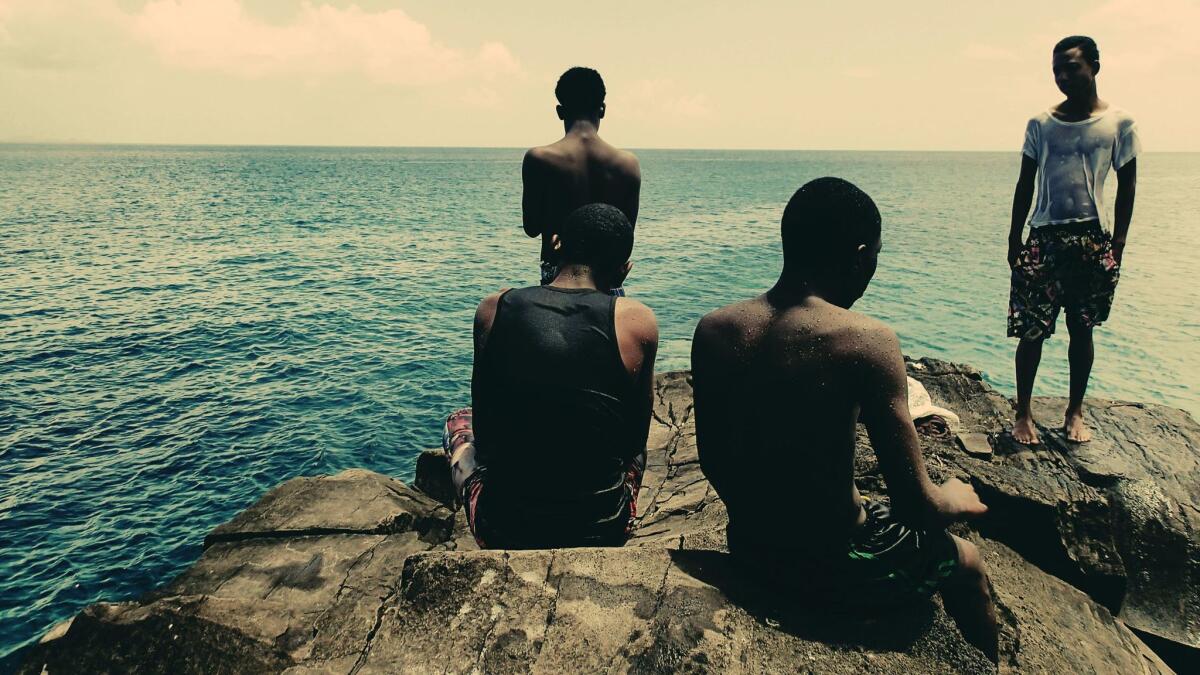
“Another Promised Land: Anita Brenner’s Mexico,” at the Skirball Cultural Center. Brenner was an American Jewish writer who was associated with an important cohort of 1920s Mexican modernists and was key to presenting Mexican art to audiences in the United States. The writer was close with figures such as José Clemente Orozco, Frida Kahlo, Diego Rivera and Tina Modotti — and some of their art is featured in the show, along with Brenner’s personal effects. Through Feb. 25. 2701 N. Sepulveda Blvd., Brentwood, Los Angeles, skirball.org.
Hugo Crosthwaite, “In Memoriam Los Angeles,” at the Los Angeles Methodist Museum of Social Justice. The noted Tijuana painter, known for phantasmagoric black and white murals that seamlessly fuse slices of urban life with the slightly deranged and fantastical, is creating an improvisational mural that is inspired by his observations of people in downtown Los Angeles. The mural will be painted only during the opening hours, during which time the public is invited to drop in and observe. After completing the work, Crosthwaite will then proceed to obliterate the piece by painting it out bit by bit. Through Feb. 25. An opening reception will take place on Oct. 14. La Plaza United Methodist Church, 115 Paseo de la Plaza, Los Angeles, museumofsocialjustice.org.
“Circles and Circuits: Chinese Caribbean Art,” at the Chinese American Museum and the California African American Museum. Latin American identity is often identified with the concept of the mestizo, the hybrid indigenous-Spanish culture that has predominated in large parts of Latin America. But the Asian contribution has been key to the development of culture, food and industry. This two-part exhibition looks at the Chinese presence in countries on the Caribbean Sea, including Jamaica, Cuba, Panama and Trinidad and Tobago. At the Chinese American Museum through March 11. 425 N. Los Angeles St., downtown Los Angeles, camla.org. At CAAM through Feb. 25. 600 State Dr., Exposition Park, Los Angeles, caamuseum.org.
“Transpacific Borderlands: The Art of Japanese Diaspora in Lima, Los Angeles, Mexico City and Sao Paulo,” at the Japanese American National Museum. This exhibition also examines the intricate nature of Latin American identity — which, in many nations, bears a distinctly Japanese stamp. Expect work by artists of Japanese heritage working throughout the continent, whose art explores issues of homeland, race and cosmopolitanism. Through Feb. 25. 100 N. Central Ave., Los Angeles, janm.org.
“Found in Translation: Design in California and Mexico,” at the Los Angeles County Museum of Art. A groundbreaking design exhibition looks at the points of connection in design — architectural, fashion, graphic and other — between California and Mexico between 1915 and 1985. It’s a thorough examination of how designers in the two locales combined local materials with an interest in pre-Columbian and colonial design, as well as folk and craft traditions, to create singular approaches to Modernism that also overlapped in countless ways. The exhibition includes a diverse range of objects, including dresses, political posters, architectural drawings, furnishings and a show-stopping late 19th century piano carved in a pre-Columbian style. Wowza! Through April 1. 5905 Wilshire Blvd., Mid-Wilshire, Los Angeles, lacma.org.
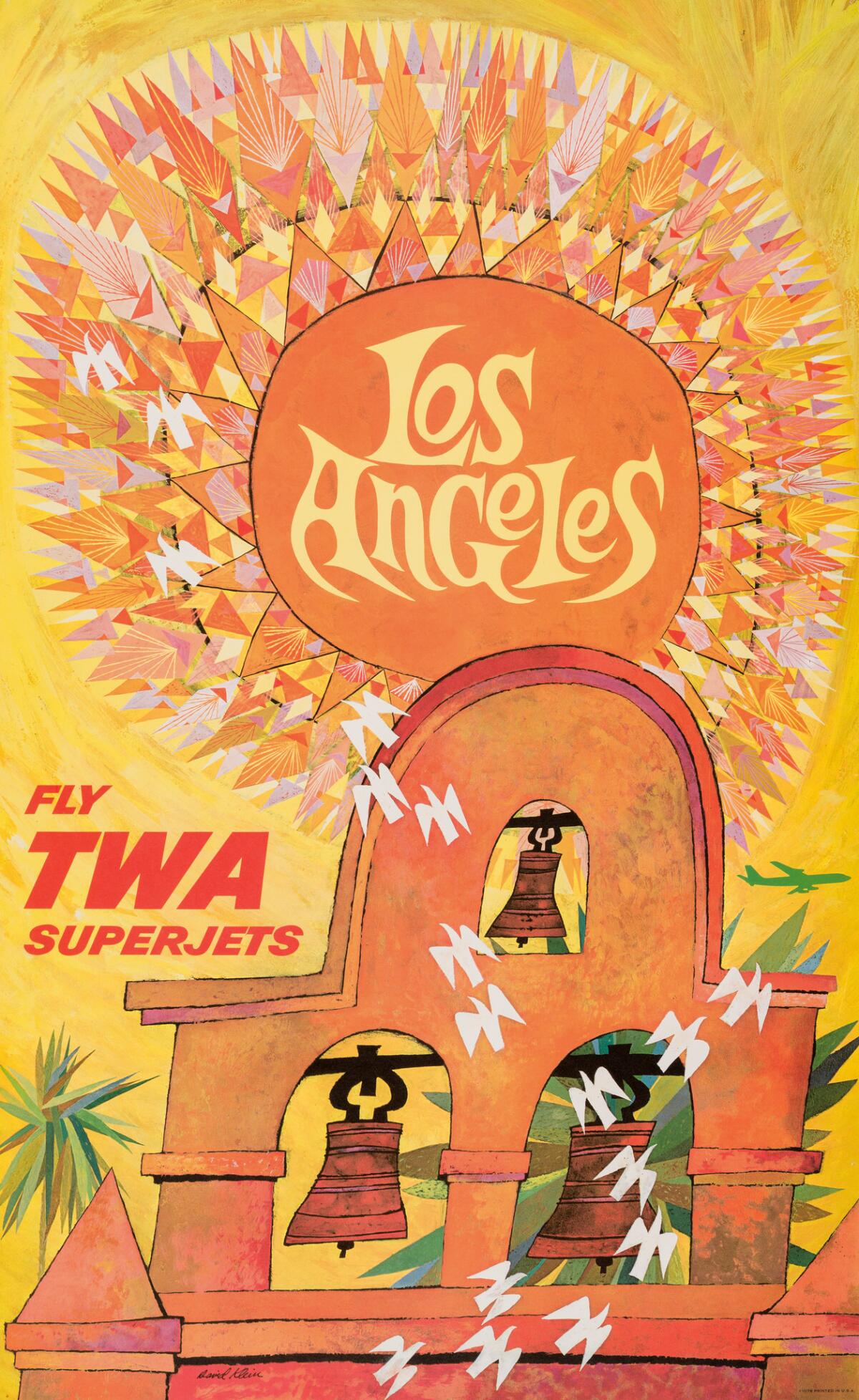
John Ford, Samuel Fuller, George Stevens, “Filming the Camps: From Hollywood to Nuremberg,” at the Los Angeles Museum of the Holocaust. Organized by the Mémorial de la Shoah in Paris, this exhibition looks at the vital work done by three key American filmmakers during World War II. Ford, Fuller and Stevens, in the employ of the U.S. Armed Forces and the Secret Services, filmed key aspects of the war — including the liberation of the Nazi concentration camps. The show includes film footage, personal letters, important ephemera and other rare objects and reflects on the way in which playing witness to Nazi atrocities shaped the worldview of these important directors. There could not be a more timely moment for this exhibition. Through April 30. 100 S. Grove Dr., Fairfax District, Los Angeles, lamoth.org.
Jose Dávila, “Sense of Place, at West Hollywood Park. Visitors to the park on Saturday can expect to find a six-ton concrete sculpture by the Guadalajara-based artist, that, after its opening, will be dispersed in pieces to sites around Los Angeles, where the blocks will take on a life of their own. Next year, the pieces will be reunited back into their six-ton block, bearing traces of the neighborhoods they have occupied. Through May 2018. 647 N. San Vicente Blvd., Westwood, nomadicdivision.org.
“Artists of Color,” at the Underground Museum. As part of its ongoing partnership with the Museum of Contemporary Art, the Arlington Heights arts space has put together an exhibition that focuses on color — on its aesthetics, as well as the roles color can play as a symbol, affecting the way it’s perceived both socially and politically. The show includes works by an array of artists, including Ellsworth Kelly, Dan Flavin, Lita Albuquerque, EJ Hill, Felix Gonzalez-Torres, Josef Albers, Carmen Herrera and Noah Davis (the late founder of the Underground Museum). It’s a striking look at color seen anew. On long-term view; no closing date set. 3508 W. Washington Blvd., Arlington Heights, theunderground-museum.org.
“L.A. Communities Through the Eyes of Artists,” in the Passageway Gallery at Union Station. For 15 years, L.A.’s principal train station has been showcasing work that reveals the city through the eyes of its artists. This year, it is showing a series of newly commissioned pieces — including Shizu Saldamando’s depiction of Little Tokyo, Sam
Alejandro G. Iñárritu, “Carne y Arena,” at LACMA. The gripping new virtual reality experience by the Academy Award-winning director places the participant in the shoes of migrants making the arduous trek through the Sonoran desert to reach the United States. This may sound like the trivialization of what can be a fatal journey, but it is not. Iñárritu has considered all of the elements that surround his virtual reality video to humanize the story of immigration on the U.S.-Mexico border. I wrote about my experience of the piece in June. It’s not cheap (it’s a $30 special admission, in addition to regular museum fees) but it’s worth every penny. On long-term view; no closing date set. 5905 Wilshire Blvd., Mid-Wilshire, Los Angeles, lacma.org.
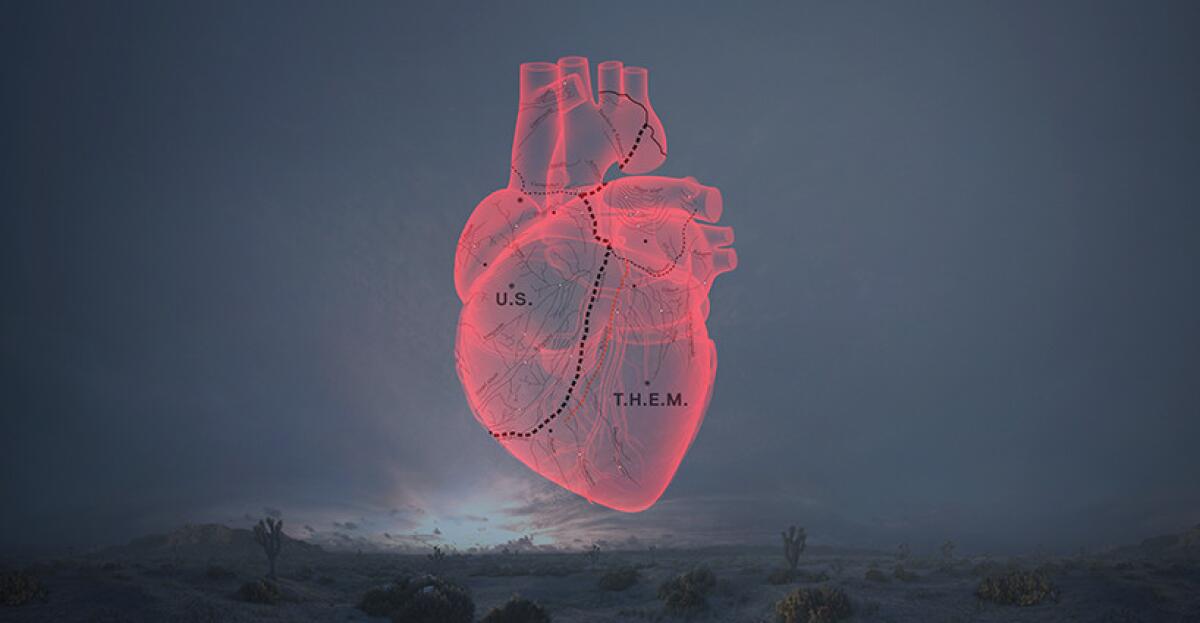
“Pow! Wow!” in Long Beach. The public mural series held in Long Beach every year is back with a series of nearly two dozen new murals in locations around the city, including parking garages and underpasses. Murals will be on long-term view in locations around Long Beach, powwowlongbeach.com.
Daniel Hawkins, “Desert Lighthouse.” The Los Angeles-based artist is obsessed with producing works that toy with ideas of grandiosity, failure and gestures that border on the Sisyphean. (One of his goals as an artist is to ultimately build a scale replica of Hoover Dam.) Now Hawkins has installed a 50-foot tall, fully functioning lighthouse in the Mojave Desert in the vicinity of Barstow. The piece even features a light to guide travelers through this rugged landscape. Directions and coordinates can be found on the website. On long-term view, Hinkley, Calif., desertlighthouse.org.
Sign up for our weekly Essential Arts & Culture newsletter »
Twitter: @cmonstah
The biggest entertainment stories
Get our big stories about Hollywood, film, television, music, arts, culture and more right in your inbox as soon as they publish.
You may occasionally receive promotional content from the Los Angeles Times.








